Can We Create Enduring Solutions to Today’s Challenges Together?


YES, AND . . . It’s a powerful mindset.

One that demands we look beyond the obvious and inspires creative collaboration in search of new connections.


Can We Create Enduring Solutions to Today’s Challenges Together?


YES, AND . . . It’s a powerful mindset.

One that demands we look beyond the obvious and inspires creative collaboration in search of new connections.


It’s the golden rule of improv, and of problem-solving as well.
It’s about taking stock of where we are, then moving forward together. Considering all the ideas, then connecting them in new ways.
Done right, both improv and problem-solving start with a scenario we must accept and build on. Both require imagination and creativity. Paying attention is key, as is committing to your partners and listening to them. Cooperation and collaboration become the building blocks of progress.
Saying yes, and opens a pathway to new solutions for difficult challenges.

Designing for the Future, And . . .
Building Resilience for an Evolving World, And . . .

Decarbonizing Today for Tomorrow’s World, And . . .
Extending Built-Environment Life Spans, And . . .
Decreasing Risk in an Uncertain World, And . . .
Creative problem solvers routinely say yes to a client’s vision. But saying yes, and is far more powerful because it opens limitless opportunities. Using this mindset to solve problems – cross-pollinating ideas and seeing what grows from them – often yields inventive solutions we would never have conceived alone.
Our clients have always challenged us to bring their visions to life. Today, we’re all called upon to solve problems broader than the scope of any individual project. Conventional thinking is being disrupted by new questions: What is this project’s impact on the environment? On people in the community? What is the future of manufacturing and supply chains? How do we deliver the infrastructure that revitalizes our urban cores? How can we make both the new and the old more resilient? These are broad, complex problems, with no clear answers. They demand we look beyond the obvious for new solutions.
Our people thrive on making yes possible. We have groundbreaking technology at our disposal like never before. In isolation, though, technology only performs tasks. Connected with a team of innovative thinkers and coupled with the mindset of yes, and, it becomes part of an engine that accelerates all of us forward.
We are ambitious in our vision – to tackle urgent problems with strategic insight, robust collaboration and creative problem-solving. Read on to see some of the ways we’re putting yes, and into action.
Jazz is the musical version of improv – and the work we do can be thought of that way too. In jazz, you’re constrained by a theme and structure, not by notes on a page. There are rules, though you can break them if doing so will drive big ideas forward. And all the players depend on each other, with everyone saying yes, and to invent what’s next.
Tom Scarangello
Pete DiMaggio Mike Squarzini Executive Chairman Co-CEO Co-CEO
How does a future-ready project team think and act?
The team’s purpose is the project’s purpose. Each member’s scope is their focus but not their only concern. Everyone looks at the overlap, where one thing affects one, two or six other things. Integrated thinking is mandatory, with all members of the team asking questions and really listening to one another.
Here are some examples of how we’re partnering with teams around the world to build the future.
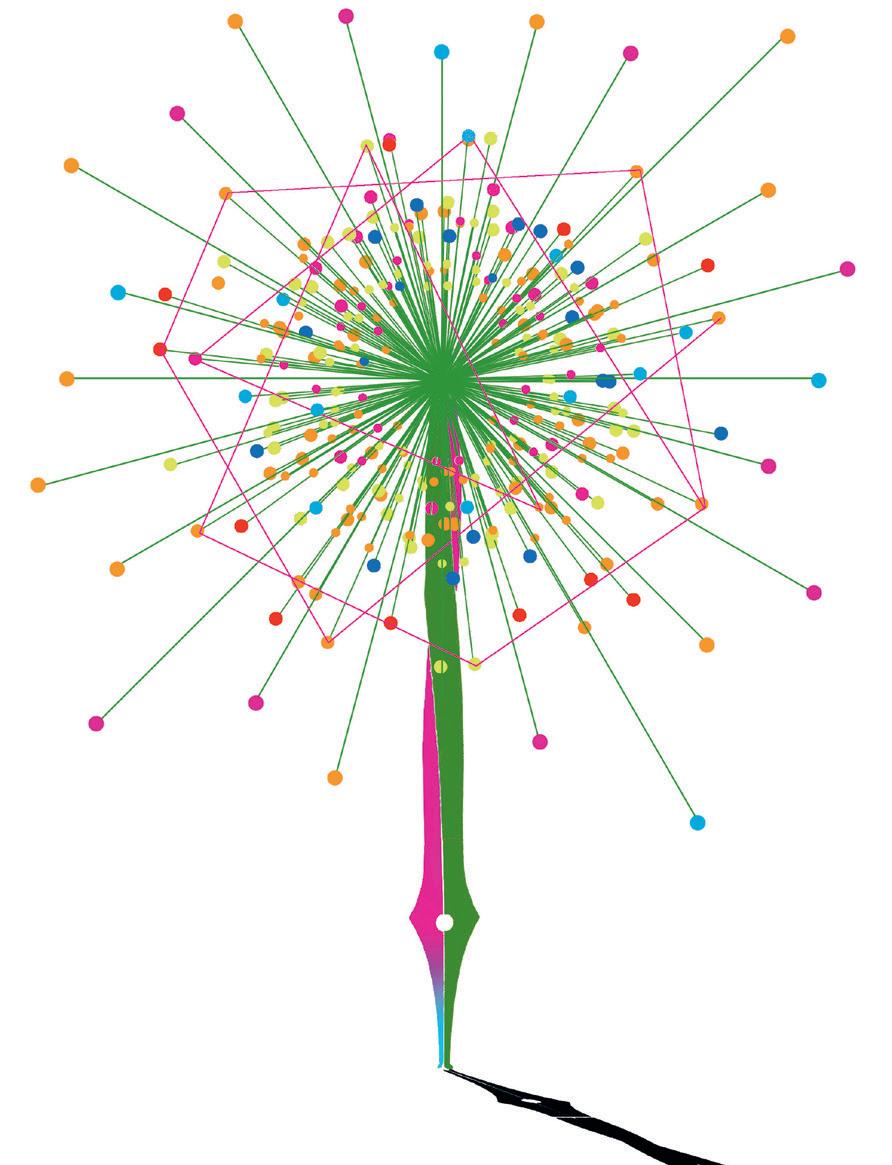


Stockholm’s historic Central Station is Sweden’s most frequented place, welcoming as many as 230,000 visitors each day. Eighty percent of the country’s train trips start or end there, and traffic is expected to increase by more than 50 percent by 2045.
To satisfy this growing demand, improve the station’s functionality and meet future sustainability goals, the city is
transforming the station and surrounding area into a mobility hub – a 155,000-square-meter mixed-use development occupying
six city blocks. The design calls for the construction of a shallow long-span deck and several mid-rise buildings over the rail yard to create
The Stockholm Central Station will be a vibrant city center and a link between the city’s east and west sides.
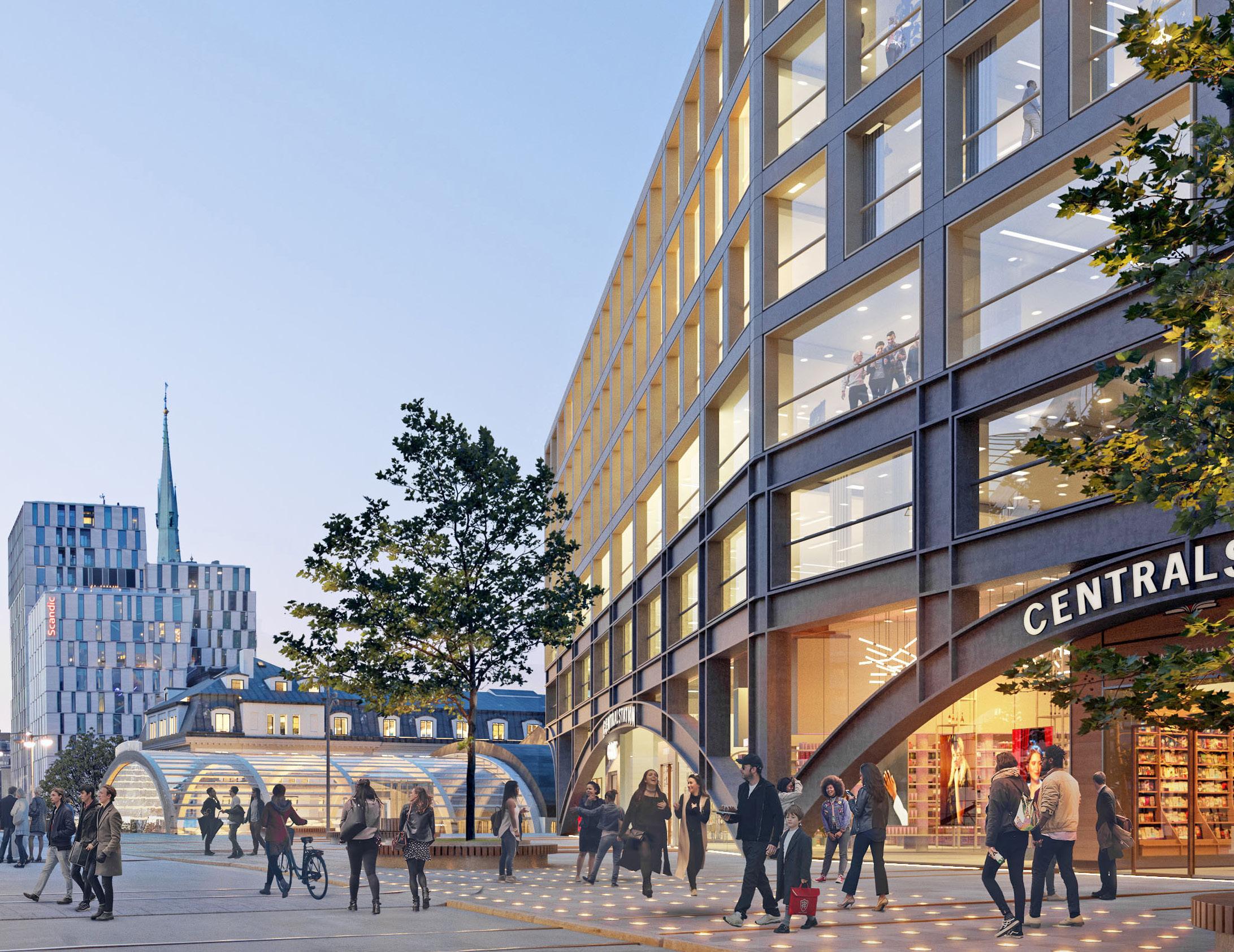
a new urban environment with offices, housing and retail spaces.
Inspired by our experience with overbuild projects – and our structural engineering and protective design expertise –project owner Jernhusen and engineering consultant Tyréns first engaged us to perform a feasibility study. But new challenges emerged as the project moved from study to design competition (with architects Foster + Partners and Marge Arkitekter, in collaboration with local engineering partner Ramboll)
and into the planning stages.
While our initial engagement was for structural engineering and protective design for the deck and the buildings above, we said yes, and as the project progressed. Yes, our construction engineering experts can determine how to build safely over an active rail yard. Yes, our vibration consulting team can calculate how shallow the deck can be without causing vibration concerns – and design tuned mass dampers to minimize unwanted movement. Yes, our sustainability consultants can
help optimize embodied carbon in the structural materials. And our façade engineers can design highperformance façades that reduce operational carbon.
Train travel generates up to 83 percent fewer carbon emissions than driving, so it’s fitting that one of Jernhusen’s goals is to create the world’s most sustainable transit hub. When it’s complete, the development is expected to contribute to the creation of 10,000 jobs in the neighborhood and more than 50,000 in the region.
As demand for electric vehicles (EVs) grows, we’re partnering with steel fabricators and erectors to optimize constructability for several U.S. manufacturing facilities. Our construction engineering services streamline fabrication and simplify erection to speed construction.
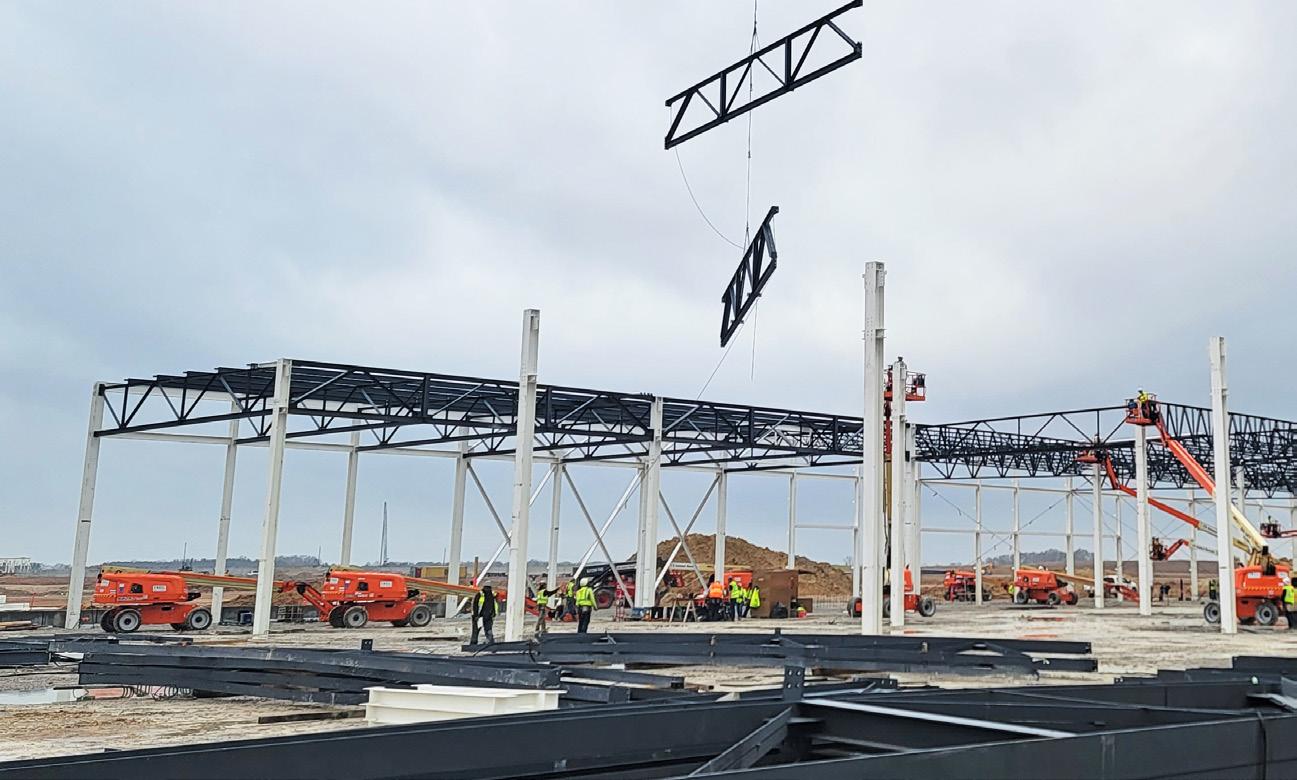
At Ford’s Blue Oval City, a sustainable EV and battery manufacturing campus in Tennessee, we provided erection engineering for an assembly building and connection design for a stamping facility.
In Arizona, we’re helping EV start-up Lucid Motors expand its production facility by two million square feet.

An innovative masstimber research facility at the University of Maine will embody the goals of its Green Energy & Materials (GEM) initiative
UMaine’s GEM initiative is dedicated to developing and demonstrating bio-based and recyclable materials in support of a sustainable future. Its Advanced Structures and Composites Center is building the GEM Factory of the Future, a research facility that will expand the frontiers of large-format and AI-enabled arrays of additive
manufacturing systems to create new markets for sustainable building materials. The 60,000-square-foot facility in Orono will include office and academic spaces.
Planners at UMaine wanted to use mass-timber construction for the new building to display – and celebrate –forward-thinking uses of renewable building materials. Their architect, Grimshaw, brought Thornton Tomasetti on board because of our experience with nonstandard mass-timber applications. “The factory area is a grand high-bay space with long spans and a unique roof form. The complex structure of the facility is proposed to be constructed entirely from mass timber,” says Vice President Chris Williams, based in our Portland, Maine, office. “The factory structure will also support cranes and other equipment, so there are a lot of unique intricacies to it.”
In Indiana, we’re providing erection engineering to Samsung and Stellantis – parent company of Chrysler, Dodge, Jeep, Ram and more – for a plant that will produce lithium-ion EV batteries.
At Envision AESC in Kentucky, we’re working on a plant that will produce the next generation of ultraefficient lithium-ion battery cells, helping make EVs more accessible and affordable.
These new manufacturing facilities won’t just deliver products – they’ll also energize local economies, jumpstart resilient supply chains and power a more sustainable tomorrow.
World’s Tallest (for Now) MassTimber Building Now Open
Ascent, the 25-story residential tower in Milwaukee, Wisconsin, opened in July 2022. Our team designed the structure for the 284-foot-tall building, which advanced the timber industry with a range of innovations and brings together the aesthetic, structural and sustainability benefits of mass timber. And we’re working on the design for an even taller timber building just down the street.
That complexity calls for more than ingenuity – teamwork is essential. Our team worked closely with architects from Grimshaw and SMRT. “The level of collaboration, creativity and expertise the crew at Thornton Tomasetti brings is unmatched,” says SMRT Principal and Senior Architect Nicole Rogers. “We’re excited to be working with such a talented group of people on such an inspiring project.”
At Thornton Tomasetti, we are committed to driving global change
and innovation. With the Factory of the Future, we’re applying innovative design to support the invention of technology that will change the way building and manufacturing shape our world.
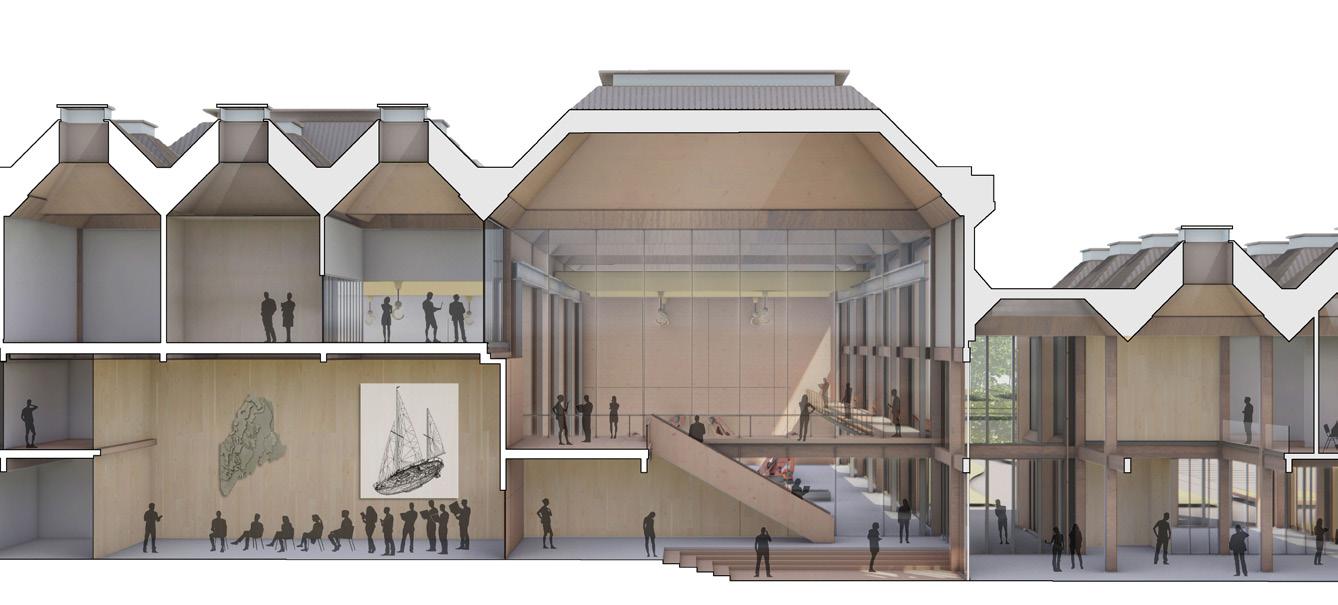

When it opened in 1998, John F. Kennedy International Airport’s Terminal One served fewer than three million passengers a year. By 2019, that number had jumped to more than four million and was expected to quickly exceed the terminal’s design capacity. Now it’s being replaced by the New Terminal One (NTO), a sustainable, futurefocused facility designed to set the standard as a global gateway.
We’re helping the future of aviation take flight at several airports, including recently completed terminals at LaGuardia and ongoing work at Hartsfield-Jackson in Atlanta and Logan International in Boston.
We’re providing several services for the NTO’s first phase, which broke ground in August 2022. The 14-gate, 1.85-million-square-foot project is being delivered by a design-build team headed by AECOM Tishman and Gensler.
We initially came on board for connection design and peer review services – another firm was designing the NTO structure. Later, our scope expanded to include value engineering.

After a pandemic-related pause, Gensler was named lead architect. They selected Thornton Tomasetti as the structural engineer of record and engaged us to perform façade engineering, protective design and construction engineering as well. We worked with the design team, including several minority partners, to adjust the structure in support of the revised architectural vision.
Our protective design and applied science teams worked together to quickly tackle several challenges. One example?
Developing advanced models of
As a response to rising sea levels, the entire NTO will be built above the design flood elevation.
how the tree columns – which support the terminal’s expansive roof – would behave under blast loading. This approach helped us optimize their design.
Creative use of hidden braced frames allowed us to trim the number and size of the columns, reducing construction materials and costs while also opening up the interior space. This change was especially beneficial for busy areas like the security checkpoint and circulation zones.
Collaboration between Gensler and our façade and structural
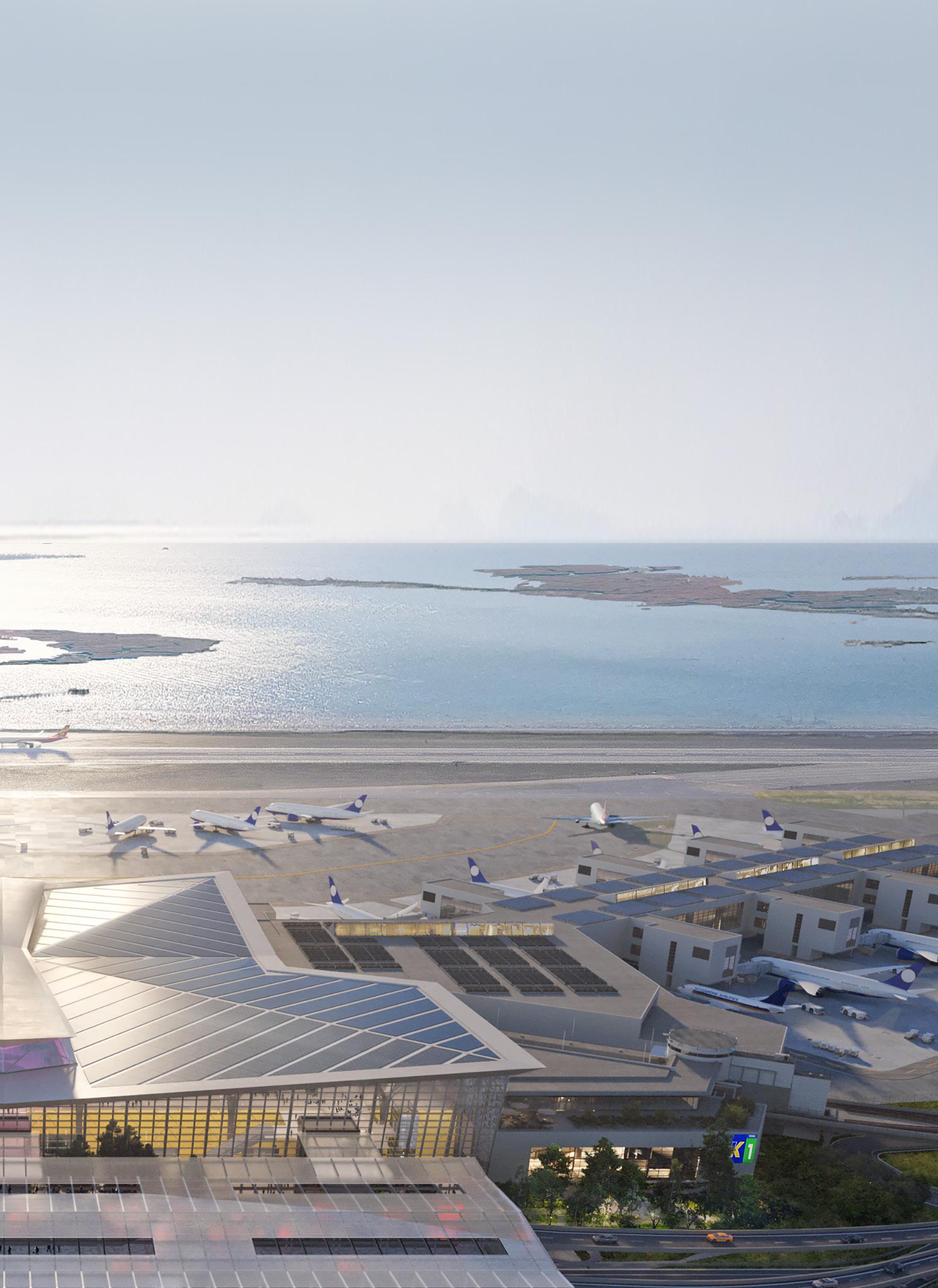
engineers was critical for the updated façade design. We opted for slender perimeter columns set 30 feet on center, an approach that opened up the façade without altering the terminal’s form. This also eliminated more than 10,000 tons of steel and 1,000 piles from the project, significantly reducing material costs – and embodied carbon.
To compensate for time lost during the pandemic, design had to move fast. We used several automation tools to speed our
work. Another big plus came from effective collaboration – our team is concentrated in New York but spread across 13 offices, so we could leverage our capacity and draw on expertise from across the firm.
Our construction engineering specialists used our Advanced Project Delivery™ process to integrate the design and construction teams, producing complete connection design much earlier than usual and delivering a detailed Tekla model. These expedited deliverables are helping speed the overall schedule.
Together with sustainability, decarbonization and corporate responsibility, resilience is a fundamental tool in our efforts to combat climate change. But how can it improve the present while helping protect our future?
We invited guest commentator Emory Lee, climate adaptation and resilience lead at Ramboll, to talk with Julie Pietrzak, the leader of our resilience practice, about the role resilience plays in our communities and the wider world.
Emory: I understand sustainability to be how we safely support human existence while maintaining balance with the natural world. Another way to think about it is, how do we operate in a way that reduces the likelihood of future environmentrelated challenges? Resilience is the
capacity to recover from difficulties – from foreseen or unexpected events. Challenges are inevitable, so how do we plan to best withstand future stressors?
Julie: Sustainability also looks for ways to reduce greenhouse-gas emissions. But even if we had already reached global net-zero emissions, more decades of warming are inevitable. Sea-level rise is inevitable. Resilience is essential for adapting to that future. Sustainability and resilience strategies often overlap. If a building can withstand an extreme weather event without requiring substantial repairs or replacement, it’s resilient and sustainable.
Julie: Climate change is one of the biggest global challenges we face, and resilient design strategies work toward adapting to future uncertainties. It’s a big ask, but it’s a process we’re up to taking on – one that involves constant iterations of learning and improving how we choose to plan and respond, while also balancing the triple bottom line.

Emory: The environment, social challenges and economic concerns: these systems all require resilience.
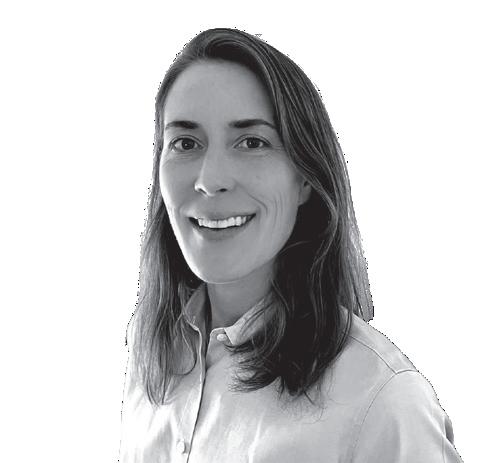

If you look at them individually and holistically, that’s where we can have the biggest impacts – where we’re soliciting stakeholder input to understand how to meet the real needs of a community and get to equitable, deep resilience.
Emory: It’s all part of the same equation. I work primarily on resilience and adaptation projects, but I’m increasingly doing decarbonization work. They’re two sides of the climatechange coin!
Julie: We’ve seen the devastation caused by our carbon-centric economy, so we know we need to change that. But along with any change, we must also recognize that we’ve gone too far down this road to completely turn back the clock. We need resilience to increase our adaptive capacity, knowing we’ll continue to face acute events like extreme weather and chronic stresses like aging infrastructure.
Emory: Economies are often resistant to change. To quicken the pace, some municipalities have started legislating resilience and
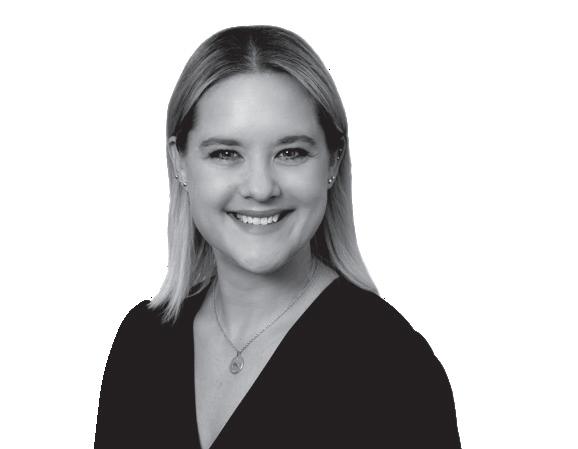
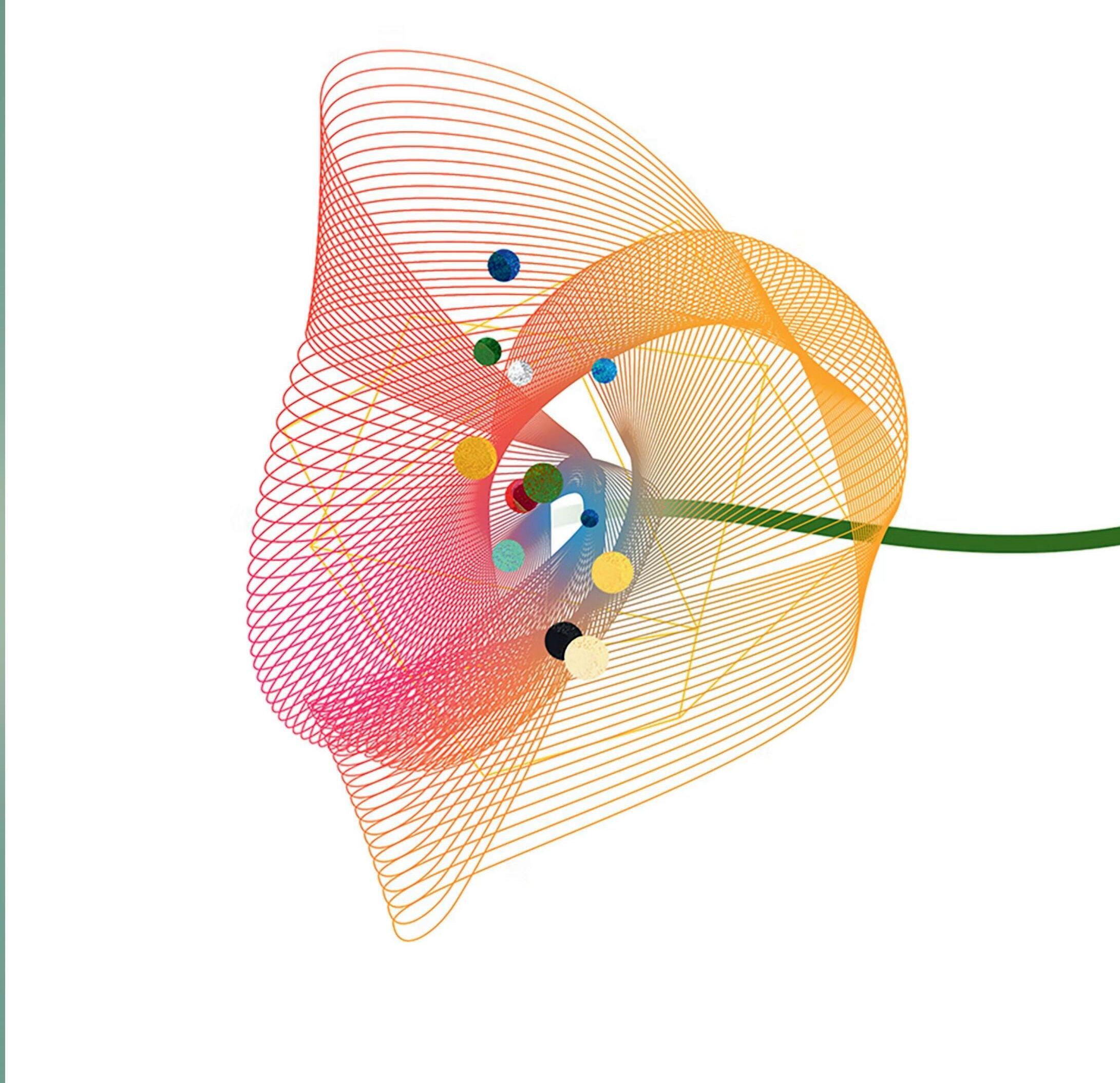
decarbonization, and I hope to see that continue. Biophilic design –looking to nature for design insights – is the optimal approach for retooling our societies to be more sustainable and resilient. I’d like to see more design influenced by nature, and a move toward flexible multifunctional infrastructure as the norm – like Amager Hill in Copenhagen, a waste-to-energy plant that also provides accessible community recreational spaces.
Julie: I’d like to see mindsets continue to shift toward environmental justice – how resilience can benefit all communities, not just prosperous ones. This concept can be integrated into every project scale. For instance, if you’re designing for district-scale resilience, identifying strategies that benefit the wider community’s emergency preparedness and response, or at a building scale, incorporating input from operations and maintenance personnel. Ultimately, it’s about building a culture of resilience that will empower the end user long after we’ve completed the project.
With its humid, subtropical climate and its proximity to the Uruguay River, Paysandú, the capital of western Uruguay’s Paysandú Department, is exposed to natural hazards like heavy rainfall and riverine flooding.
According to a recent Intergovernmental Panel on Climate Change (IPCC) report, the impacts of climate change in this region are already evident and will continue to intensify as global temperatures rise. Without resilience planning, these hazards could lead to power outages, flood damage, service interruptions, and a host of other problems.
Our team, led by architect OMA, with landscape architect West 8 and mobility specialist MIC-HUB, prepared a resilience-focused
master plan for developing and revitalizing the city’s waterfront. The plan, for a 3.5-square-kilometer area along the river, sets out ambitious guidelines for culture, sports, leisure and real-estate development. It also calls for the creation of a lagoon and construction of a university campus. For many in the city, the vision effectively transforms the threat of flooding into a promise of rebirth. We performed a comprehensive resilience assessment that considers future climate risks and proposes strategies to limit their
“What we saw as a threat, we are going to see as an opportunity,” says Paysandú Mayor Nicolás Olivera, commenting on the master plan’s principles of “resisting, protecting and adapting to water.”
impact. Our goals? To adapt to future climate change; protect the ecosystem; minimize damage and loss of property value; and prevent interruptions to business, school and critical services. The plan also promotes public safety and enhances quality of life by offering new amenities; mitigating the effects of extreme heat, droughts and floods; and ensuring equitable access to the waterfront.
Riverine flooding is the most significant climate risk in Paysandú, having caused widespread damage

In December 2022, Thornton Tomasetti staff, along with other team members, presented the Paysandú master plan to Uruguay President Luis Lacalle Pou (front left).
to the city in recent years. Our resilience plan will improve the city’s storm drainage system and connect the community to one of its greatest resources: its ample waterfront. Raising land elevations, introducing protective berms and flood walls, and directing river overflow into absorbent wetlands are complementary strategies for protecting the natural landscape and the unshielded urban areas along the river.
Streets will be designed to enable safe access for pedestrians, cyclists,
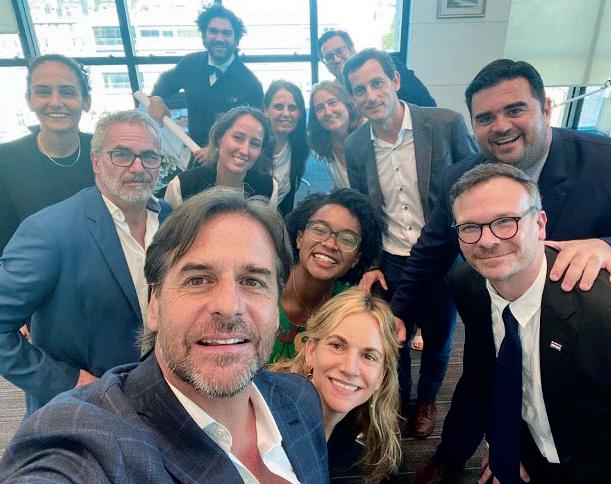
motorists and transit riders while supporting green infrastructure for stormwater management. And buildings will be protected by flood walls and barriers, berms, elevated critical equipment and utility access points, watertight sealing systems, and watertight building envelopes.
Land-use planning will consider
not only the likelihood of future hazardous events, but also the goals and aspirations of the community. For each neighborhood and building, a flood emergency action plan will empower residents to respond to flooding events and deploy resilience measures – long after we’ve left the premises.


In New York’s West Chelsea Historic District, the massive Terminal Warehouse, where freight trains once unloaded goods ferried across the Hudson River, is undergoing a large-scale renewal. This landmarked structure, which was built in 1891, will have a new life as a Class A office and retail destination.
Building owners L&L Holding Company and Columbia Property Trust initially selected Thornton Tomasetti for historic building-envelope restoration and façade-engineering services. But within a few months, we were invited to take on sustainability and resilience services as well.
Our teams collaborated to develop creative ways to preserve the historic building’s features, including the
two enormous arched doorways through which freight trains once rumbled. The tracks are still visible inside the building, along the main archway. Our preservation strategies often coincided with sustainability and economy, as when our plan for salvaging and reusing many of the original brick walls, as well as in situ upgrades, both saved money and reduced embodied carbon.
Over the years, several of Terminal
Warehouse’s 600 classic arched windows and entryways had become damaged or deformed by age or fire. We preserved and stabilized those that were salvageable and replaced any that weren’t, closely mimicking the look of the originals.
But while major emphasis was placed on preservation, the warehouse also underwent massive alterations, including construction of a two-story glass-and-steel

The renovated Terminal Warehouse will feature an elegant central courtyard with cascading terraces.
Memphis International Airport serves 358,000 passengers every month. It sits near the New Madrid Fault line, a potentially deadly seismic zone that is six times larger than California’s San Andreas Fault. Built in the 1960s and ’70s, the airport was constructed before codes addressing the local seismicity were introduced.
As part of a sweeping renovation, our team provided structural design, façade engineering and sustainability services to help modernize the stem and southeast leg of Concourse B. The renovation, designed by Alliiance in association with UrbanARCH Associates, enhanced safety and improved the
passenger experience by creating higher ceilings, wider corridors and more energy-efficient spaces – and brought the terminal in line with modern seismic standards.
Our design raised the roof height from 12 to 20 feet and reduced the seismic load by 60 percent. How? By replacing the upper level and its heavy concrete columns with long-span steel trusses that traverse the width of the concourse. A lightweight lateral system design – composed of dual concentrically braced frames at the arrivals level and vertically cantilevered perimeter columns at the departures level –made the structure an estimated 15 times more resilient against seismic forces.
The angles of the new ceiling design echo the shape of the original terminal building’s iconic martini-glass columns.
overbuild and installation of an open-air courtyard, which required cutting a large hole in the center of the building and removing a sizable portion of its structure. Our analyses of leakage, loads and stresses helped determine which modifications would be feasible without affecting the historic character of the building and helped stabilize it during installation of the courtyard and overbuild.
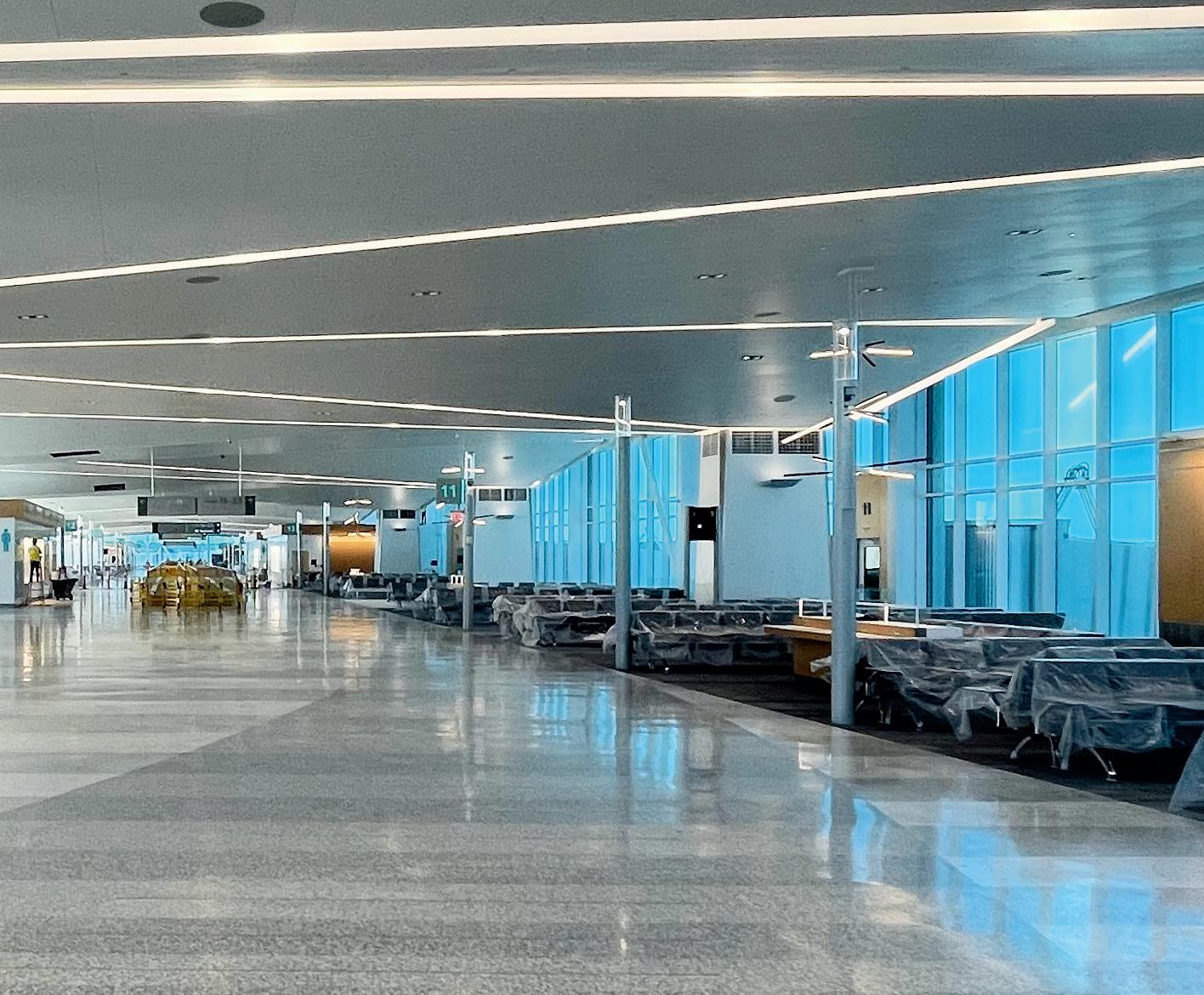

To accelerate action against climate change, the 2015 Paris Agreement established a multinational goal of limiting the rise in global temperatures to 2°C –preferably 1.5°C – above preindustrial levels. This ambitious goal is attainable, but only through monumental, cooperative efforts to reduce the amount of CO2 released into Earth’s environment.
What does decarbonization entail, and what does its future look like? We sat down with Associate Principal Tim Ashworth, Vice President Emily Kunkel, Principal Scott Schneider and Senior Principal Pawel Woelke to discuss.
BRIEFLY, WHAT IS DECARBONIZATION?
Tim: It’s reducing greenhousegas emissions from everyday processes like energy generation; distribution and use in construction, manufacturing and transportation; and agricultural processes.




Emily: Construction, manufacturing and the burning of fossil fuels inevitably produce greenhouse-gas emissions, so another part of the equation is direct air capture –removing CO2 that is already in the atmosphere.
Pawel: Large industrial countries are the main sources of CO2 emissions. But islands and coastal countries that contribute the least may be the hardest hit. We’re in a position to help those who might not have the means to help themselves.
Scott: Climate change is the most pressing problem the world faces. We want to do all we can to solve it –to make the world a better place for our kids. It’s a global challenge, and it’s hard. But we’re good at solving hard problems.
Emily: We’re linking industries with novel approaches to decarbonization and introducing them to carbon capture and storage, hydrogen, and other options for energy supply and materials manufacturing. We’re also enabling expansion of renewables, safe deployment of energy storage systems and small nuclear reactors, and providing the means to track
and manage embodied carbon in building projects.
Scott: We can’t solve the whole problem alone, but we can encourage others to move in the right direction – we can help architects to design efficient buildings, suppliers to alter how they source and make concrete, and stakeholders in other industries to think about new materials with smaller carbon footprints.
Pawel: We’re leading the discussion with clients and engaging the public as well. In addition to explaining the value chain of energy supply, distribution and demand, we can help them team with others to accomplish their objectives.
WHAT NEW APPROACHES DO YOU EXPECT TO EMERGE WITHIN THE NEXT FIVE TO 10 YEARS?
Emily: CO2 utilization will continue to develop. Commercial technologies will emerge for manufacturing products with CO2 rather than injecting it underground. It could be used to make fuels or materials that help reduce embodied carbon in concrete.
Scott: New, lower-carbon building materials. And because we build with so much concrete, it’s an area where we’ll see big investments – mixes that use little to no cement, new ways of manufacturing and more efficient transportation methods.
Tim: Small and micro modular reactors already use nuclear fission to produce electricity, but I think fusion will happen too. This transition will be powerful, because with the abundant energy they both generate, we can electrify most processes. We can also expect major advances in grid-scale batteries.

Electrification is a vital component of decarbonization – and that makes energy storage critical to efforts to limit climate change. But lithium-ion batteries in energy storage systems and electric vehicles pose unique fire and explosion risks. We manage these risks through holistic analysis of the ways people, products and building systems interact. Using science and engineering, we can help incorporate this important technology safely.

We collaborated with clients, contractors and other disciplines to push the boundaries of sustainability.
Engineering a six-story, 462,000-square-foot research facility to meet ambitious sustainability goals posed a welcome challenge for our team. Our sustainability experts, façade designers, structural and construction engineers, acoustics and vibration specialists, and protective design engineers worked together to provide the building’s owner and the tenant with an efficient, coordinated design for the composite-steel structure and its fit-out. Since vibration control is paramount for laboratories housing ultrasensitive equipment, we performed vibration analyses for the whole building – and for the fit-out – and installed five tuned mass dampers.
To counteract the high energy demands that are typical of laboratories, the owner and tenant were committed to extreme sustainability. Features like highperformance triple-glazed façades, exhaust-air heat pumps, rooftop solar panels, stormwater capture and geothermal systems will offset energy consumption and help the facility earn LEED Platinum Core & Shell certification.
Throughout the design process, our team continually fine-tuned the structural system to reduce embodied carbon (EC) in the composite floor decks, steel framing and concrete foundations. During procurement, we used our EC specifications – completed
in 2022 – to set bold reduction goals for the concrete used in the building and worked with local suppliers to meet these requirements, with no significant increase in cost.
A whole-building life-cycle analysis performed for the project showed a 17 percent reduction in CO2e relative to a baseline created in One Click LCA lifecycle assessment software. This significant reduction – in both the structural and whole-building EC, per LEED v4.1 guidelines – is one example of the innovative features contributing to the success of this project, which will be one of the most sustainable laboratory buildings in Greater Boston.

We recently updated our Division 1 Specification 018113 – Embodied Carbon Design Requirements – to address EC in steel and timber, in addition to concrete. This specification is one of the first of its kind in the AEC industry.
We also provided data from 30 projects to the SE 2050 Commitment database, more than most contributing firms.
Moving at twice the speed of the world’s fastest train, Hyperloop Transportation Technologies’ HyperloopTT system bridges the gap between train travel’s comfort and convenience and air travel’s speed. Passengers on HyperloopTT will ride in a capsule that is magnetically levitated within a low-pressure tube. And since it’s all electric, the system could yield enormous reductions in carbon emissions related to intercity travel.
Thornton Tomasetti has a significant stake in this cleanenergy technology – as an investor and an engineering
partner on the project. We recently concluded a twoand-a-half-year study with the submission of our final report on the system’s operational safety. The report included an analysis of external threats, such as terrorist attacks, and a mitigation plan to address those risks.
We’re also supporting an application by HyperloopTT, with ENSCO and Colorado State University Pueblo, for a Federal Railroad Administration CRISI (Consolidated Rail Infrastructure and Safety Improvements) grant, to fund the development of a test track in Pueblo for further research.

High-performance offices. Lower travel emissions. Reducing energy use. Renewable energy. Flexible work.

Absolute emissions (MT CO 2 e)
Carbon footprint per capita (MT CO 2 e)
Our goal is to achieve carbon-neutral business operations by 2030. We’re meeting our targets (black) and planning for our future (gold).
Since 2012, we’ve been steadily moving toward our goal of carbon-neutral business operations by 2030 – by limiting activities that produce greenhouse gases and offsetting any emissions that remain.
This initiative complements our project work, where we’re reducing emissions from buildings and developing innovative decarbonization solutions. We make progress toward these targets by:
Designing high-performance offices. We apply our sustainable fitout policy to all major office moves and renovations and encourage green-building certification, so our energy-performance goals
exceed minimum standards. In our offices, green champions work to reduce energy use according to our sustainable-office guidelines.
Using renewable energy. We’ve met our green-energy purchasing percentage targets every year since 2015 as a member of the U.S. Environmental Protection Agency’s Green Power Partnership. And for 2022, we purchased green power through renewable energy
certificates (RECs) for 59 percent of our U.S. electricity use.
Flying less, offsetting the rest. The pandemic required us to become better at building relationships without traveling. With robust tools to enable remote meetings, we’re actively seeking ways to minimize travel. And we’re encouraging reductions by sharing our data. Since 2014, we’ve offset all our air travel as a businesscritical activity.

44% decrease in absolute emissions since 2018
2.0 per capita carbon footprint (metric tons CO2e), not including offsets and RECs
151 U.S. households –annual equivalent of CO2e emissions offset since 2012
59%
U.S. electricity use that is green power purchased through RECs
12 offices certified under a green-building program or equivalent
162 environmental and social grants to offices
60 green champions in 33 offices
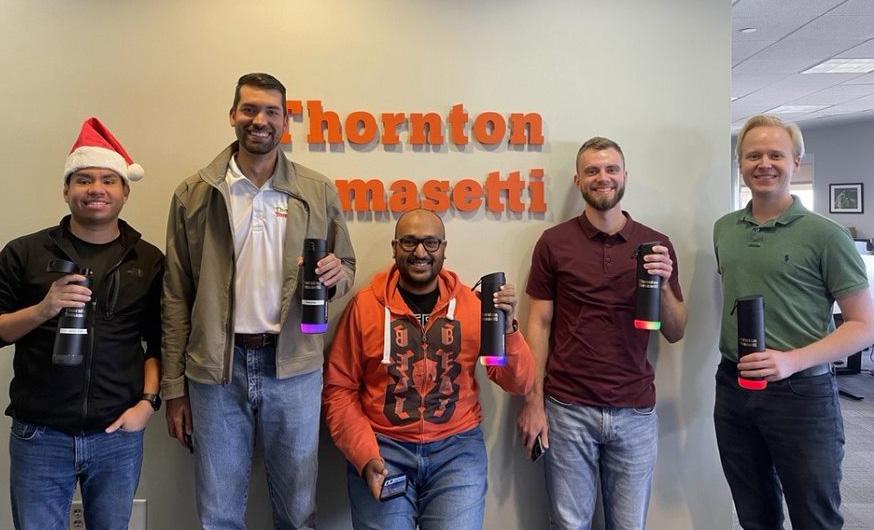
Our Tampa, Florida, office received one of 22 grants awarded to support progress toward carbon neutrality and other corporate responsibility goals. This office reduced waste and improved wellness by purchasing reusable bottles that track the amount of liquid users drink.
Enabling flexible work. In 2017, we established a global flexibility policy, offering work options that reduce commuting emissions while maintaining our collaborative culture. A recent survey shows 92 percent of our people are satisfied with workplace flexibility.
Our 2022 carbon footprint reduction surpassed our targets. We calculated* the carbon footprint of 29 large offices and found that 19 had reduced greenhouse-gas emissions since 2018, our baseline year. Absolute emissions from electricity use, heating fuel, waste, commuting and business travel totaled 2,733 metric tons of CO2e, lower than in 2018.
The shift to remote work caused by COVID-19 curtailed commuting and business travel, leading to a 61 percent decrease in absolute emissions from 2018 to 2020. As the pandemic eased, commuting and air travel rebounded. Combined with the firm’s growth, this led to a 47 percent increase from 2020 to 2022. Our total reduction for 2018 to 2022, however, was 44 percent. We attribute that overall decrease to
efforts to reduce air travel, moves to more energy-efficient office spaces, and less commuting. When purchased offsets and RECs are accounted for, we have achieved a 58 percent reduction in emissions.
*Due to a calculation error, the print version of this report differs from this corrected data.

Green champions in our Denver, Colorado, office organized a day in which employees assisted with improvements to City Park.
The built environment is rife with structures that are nearing the end of their intended service lives. But it’s neither practical nor environmentally responsible to demolish them all and build anew. Our multidisciplinary teams are working on many fronts to make these structures safe, functional and useful far into the future.
Two of our rehabilitation experts, New York-based Principal Anita Asokan and California-based Project Engineer Francisco Galvis, talked with Greg Deierlein, the John A. Blume Professor of Engineering at Stanford University, about extending the service lives of aging structures. Here are their takeaways.
increasing risks, like earthquake demands or sea-level rise in coastal areas, that weren’t understood at the time of construction.
Francisco: Renewing the built environment presents an opportunity to use what we know now to tackle those kinds of risks. We can help clients make cost-effective investments that address multiple issues and improve community safety.

Anita: I’m an architect, so I think about what a building brings to the community. A building is like a living system, and without regular maintenance and repairs, it starts to die. Then the culture and history of the time when it was built are slowly lost.
Greg: Renovating a building that doesn’t conform to current codes and may be deteriorated is a harder technical problem than building a new one. Many firms can design a new building, but not all have the specialties needed for the situations you encounter with rehabilitation.
Greg: It’s inherently cost-effective. And it’s much better for sustainability if you’re not demolishing and rebuilding. When a structure is at the end of its service life, what’s the issue? There’s obsolescence – a building might outgrow its use; a bridge might not carry enough lanes. There’s deterioration. And then there are
Francisco: Looking at renovation versus new design, you want to inform the owner about the options, but not advocate, because you could lose credibility. Our job is to lay out the landscape of options, to provide clients with the right tools to make a decision.
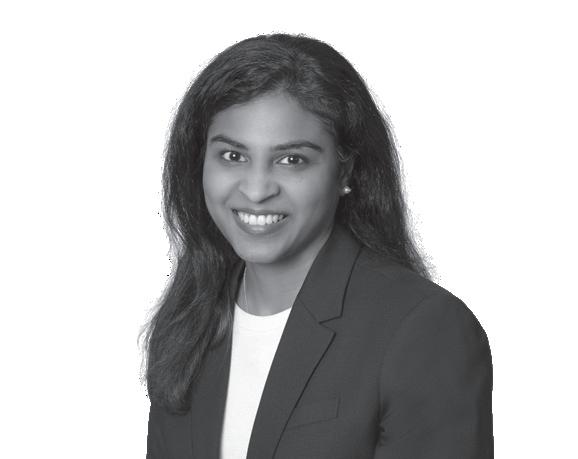


Anita: Letting a structure deteriorate adds liability and subtracts value. Maintenance usually costs less than repair, so there needs to be a systematic approach owners and property managers can take. It’s up to us to help them understand how.
Regulations help too. New York’s Façade Inspection and Safety Program requires evaluation every five years. Several cities now have similar laws. And they passed SB 4-D in Florida, so condominiums get the maintenance they need to stay safe (p. 26).
HOW SHOULD THE AEC INDUSTRY PARTNER WITH OTHER STAKEHOLDERS?
Anita: Building code committees play a crucial role. We have to work with them in shaping and implementing the codes, because it’s not just engineers and architects in these committees; there are other groups, like material suppliers and product manufacturers. They need to be informed about potential new risks and emerging technologies.
Greg: Working with local governments is important too, because informed policymakers make better laws. Another opportunity is educating homeowner associations and condo and co-op boards. They’re often made up of residents who aren’t experts in these issues. We can help them plan for the major investments that are needed to maintain or upgrade their buildings.
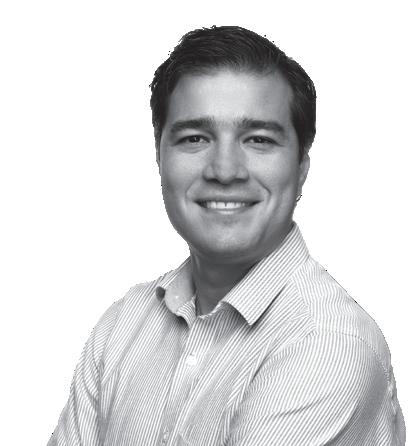

Francisco: We can also inform clients of the implications – the costs and benefits – of, for example, choosing a code-minimum building versus going beyond the code.
The insurance industry can have a big impact as well. We can offer information on the actual value of certain upgrades, so insurers can offer incentives for clients who proactively reduce their risk.
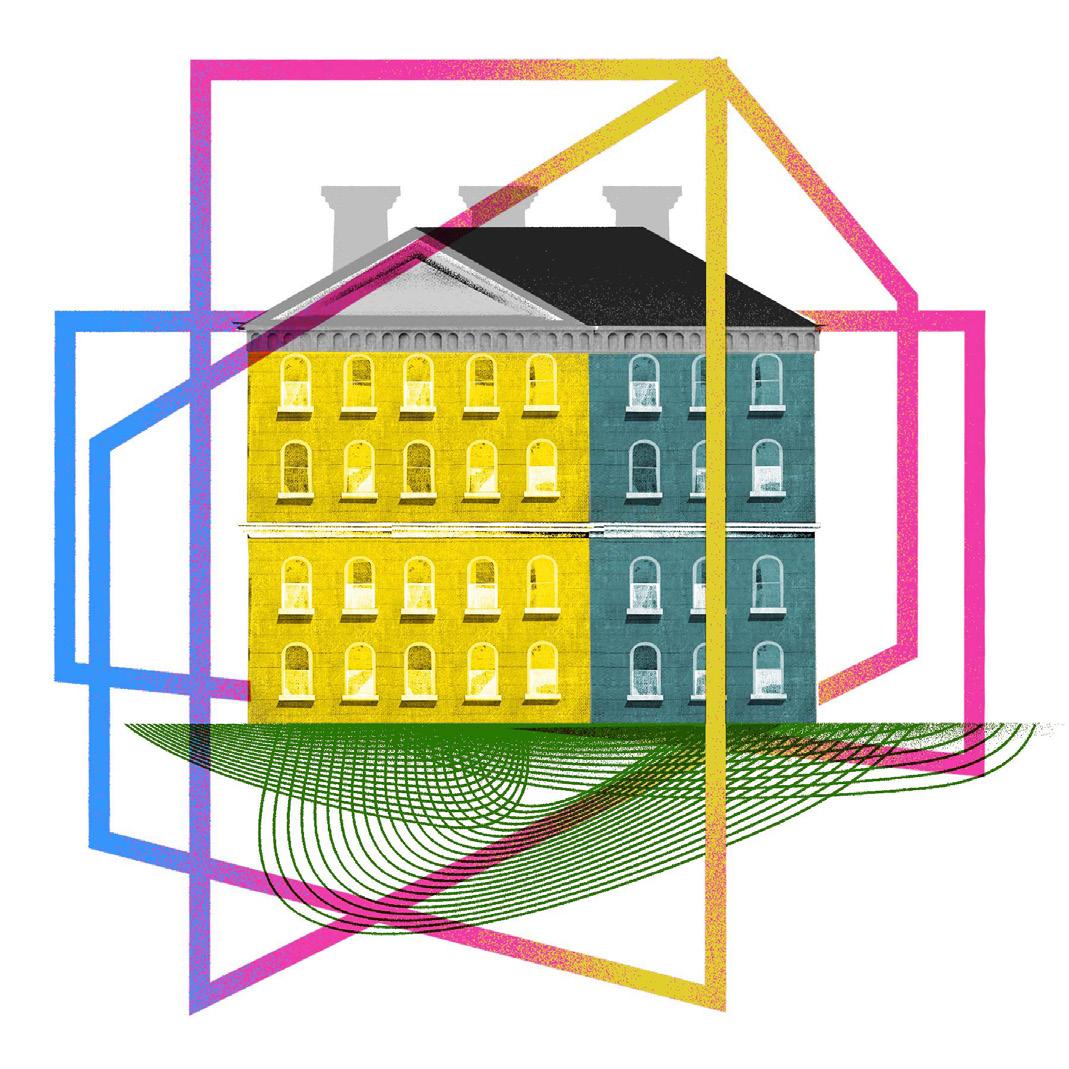
WHAT NEW TECHNOLOGIES WILL WE SEE IN COMING YEARS?
Anita: AI and related technologies will be significant. We’re already using them with our T2D2 application – a drone photographs the entire façade, and an AI process categorizes and documents defects like cracks and spalls (p. 48). It’s much less costly than putting people up on scaffolding, so you can do it more often. Then you can compare results from six months earlier, or a year, and find problems early.
Greg: Collecting data to improve our ability to model building performance. After monitoring 50 façades, you have knowledge you can use to advise the owner of the 51st about the benefits of particular upgrades or the consequences of deferring maintenance.
Francisco: Constant communication between recorded data and models – digital twins of buildings – will help us see problems as they start, in time to help clients make timely and cost-effective interventions.
In response to the tragic collapse of the Champlain Towers South building, the Florida Legislature passed Senate Bill 4-D in 2022. The law requires that all condominium and co-op buildings with three or more stories undergo periodic inspections of their structural integrity, and that reserve studies be performed to establish funds for necessary repairs.
Staff in our Florida offices are working with building owners, associations and insurers to carry out SB 4-D’s requirements. We’re also at the forefront of helping these groups understand the law’s provisions, through educational presentations that break down its components and consequences.
Aging infrastructure is a problem.
In 2018, the number of U.S. bridges in “fair” condition overtook the number of those in “good,” and deterioration exceeds the current rate of repair.* This trend inspired Fort Lauderdale-based Associate Antonio de Luca to develop an R&D project that aims to prevent damage rather than react to it.
He’s testing a cast-in device that can monitor electrical activity in the rebar within concrete to detect the start of corrosion. The
device transmits data frequently and in real time. “Looking inside” concrete this way could help stop incipient deterioration before it causes real damage.
The goal of the study is to learn how to best apply machine learning to information from current monitoring and past inspections to better predict how a structure will perform over time. This will enable better planning for preventive maintenance, with benefits for budgets and public safety.
Reactive maintenance is the current industry practice, but monitoring and prevention are less expensive and can lengthen service life. * ASCE 2021 REPORT CARD FOR AMERICA’S INFRASTRUCTURE

Senior Engineer Kevin Matheus assesses structural conditions at a condominium building in Florida.
the Flushing-Main Street station opened in 1928, it stood in a quiet suburban neighborhood. Today it’s one of the busiest stations in the New York City Subway system. We’re providing multidisciplinary engineering services for a designbuild upgrade project.
Our structural engineers evaluated conditions and designed state-of-good-repair improvements, new entrances, and several new stairways at both the street
and mezzanine levels. Our civil engineering team designed roadway restoration, work-zone traffic control measures and permanent utility relocations. Our geotechnical engineers performed subsurface investigations, testing and foundation design. We also designed support-of-excavation systems and inspected buildings adjacent to the excavation.
We worked closely with architect LHP and general contractor ECCO III to minimize the work’s impact on dayto-day operations. When complete, the upgrades will enable the station to efficiently serve more people and keep the structure in good condition as it heads into its second century of service.
Withdemand for office space down, the conversion of office buildings into lab space is taking off, especially in research hubs like East Cambridge, Massachusetts. Staff in our Boston, London and Mississauga offices are helping turn two six-story buildings – originally designed by our engineers in 1988 and 1995 – into 370,000 square feet of modern, sustainable space suitable for life-science research. Our team provided structural evaluation and design and floor-vibration analysis for the renovation. Our construction engineering specialists developed a design for temporary shoring and rigging for mechanical, electrical and plumbing (MEP) equipment. We also used bioclimatic computational fluid dynamics modeling in a wind
reentrainment study to help the team’s MEP engineer understand –and thus minimize – the impact of lab exhaust on the surrounding area’s air quality.

This vibration heat map shows predicted velocities of floor movements, in microinches per second, caused by people walking at 75 steps per minute. Blue denotes the lowest velocity, and red the highest.

New and rehabilitated entrances at the intersection of Main Street and Roosevelt Avenue.
After a severe cold snap, an electrical plant in Illinois had a problem: metal tubes in an air-cooling condenser (ACC) unit had buckled. The system still worked, but the owner wanted to know precisely what had happened and if the longevity of the system would be affected. Our structural, mechanical, metallurgical and advanced modeling specialists combined their expertise to uncover the answers.
Acombined-cycle plant uses gas to generate electricity, then uses exhaust heat to make steam, which runs a turbine to generate more power. The steam is condensed in an ACC unit so the water can be heated and used again. Steam pumped through large arrays of tubes is cooled by a series of fans.
We started with a thorough assessment: reviewing design documents and operating procedures, inspecting the site and measuring damaged tubes. We determined that the rapid change in temperature as hot steam hit the cold tubes had caused them to buckle. A new cold-weather start-up process was developed for future operations.
Next, our team used infrared cameras to evaluate the ACC’s thermal behavior during normal operation. We built a global structural model in which we analyzed the results and evaluated the ACC’s structural stability. That, in turn, provided the deflections and forces needed for a fatigue and life-expectancy assessment.


We used an infrared camera to capture thermographic data during a day of normal operations. Black denotes the coolest temperatures, white the highest.
Our team then used multiple finite-element analyses to check for residual strains and stresses in the damaged tubes, determine their post-buckling capacity and look for any behavior that could affect function. To predict the unit’s remaining service life, we performed a fitness-for-service analysis, applying a series of thermal-cycle loads based on the number of cycles the ACC undergoes in a year.
Our investigation concluded that the ACC can fulfill its expected 30-year service life. It also helped stakeholders understand the issues and make analysis-backed decisions about how to move forward.
The Throgs Neck Bridge is a six-lane suspension bridge that spans New York’s East River. Opened in 1961, it requires near-constant repairs and upgrades to keep up with its heavy traffic load.
We’ve worked with the Metropolitan Transportation Authority (MTA) Bridges and Tunnels for decades to help maintain this key piece of infrastructure. Most recently, we designed an innovative replacement for the bridge’s aging deck.
With the original concrete deck nearing the end of its service life, our engineers designed a new orthotropic deck that is expected to last a full century. Comprising a structural steel deck plate
supported by ribs, an orthotropic deck bears the live loads of vehicles and contributes to the bridge’s structural loadcarrying capacity.
The service life of this new deck will greatly exceed the 50 to 75 years that is usual for grid decks. How did we do it? We performed full-scale prototype testing at Lehigh University to evaluate and validate the fatigue performance of the new deck system. Our design also eliminates joints throughout the span, removing a

potential source of corrosion. The composite action of floor trusses and stiffening trusses increases the bridge’s live-load-carrying capacity, so it could carry more traffic lanes in the future.
Our team has been designing orthotropic deck systems since the 1980s and continually fine-tuning the system to be more efficient and longer-lasting. This latest design represents the next step, one that will help the Throgs Neck Bridge operate safely and efficiently for many years to come.

Redevelopment of the three-acre Mercy Hospital campus will make way for Winter Landing (left foreground) and the Equinox (left background) affordable housing developments.
When engineers, scientists and designers say yes, and, doors open to opportunities . . . to apply our expertise to help people recover from natural disasters. To address the shortage of affordable housing. And to accelerate the approval of lifesaving medical devices. Opportunities to support potential in students and in our staff. And to help colleagues from all backgrounds achieve professional and personal success. Because in everything we do, helping people thrive is what counts.

Amassive redevelopment of the 1940s-vintage Mercy Hospital campus in Portland, Maine, will feature two of the state’s first all-electric affordable housing projects, including 95 units designed to Passive House performance criteria. They will be among the first projects to meet Portland’s Green New Deal energy efficiency standards.
Winter Landing’s energy footprint will be 34 percent more efficient than that specified by the American Society of Heating, Refrigerating and Air-Conditioning Engineers (ASHRAE). Collaboration between our structural and sustainability teams, in coordination with CWS Architecture + Interior Design, accelerated accurate energy modeling for thermal bridging and insulation details.
Next door, we’re providing sustainability consulting to Ryan Senatore Architecture for the equally energy-efficient Equinox development, which will include 43 of the 95 units.
The annual operational energy cost savings projected for both developments is $57,000, compared to the widely used ASHRAE baseline.
The rental units, developed by Community Housing of Maine and Portland Housing Development Corporation, will provide homes for residents earning less than 60 percent of the area’s median income, help alleviate a rental housing shortage, and provide walkable access to the city’s West End neighborhood.
The Thornton Tomasetti Foundation is an independent nonprofit organization that helps more young people say yes, and to careers in building engineering, design and technology by funding scholarships and fellowships for undergraduate and graduate students.
$196,000 IN SCHOLARSHIPS AND CHARITABLE CONTRIBUTIONS, INCLUDING $41,000 TO FIVE COLLEGE STUDENTS THROUGH ITS NATIONAL SCHOLARSHIP PROGRAM AND STUDENT INNOVATION AND TECHNICAL LITERACY FELLOWSHIPS.
The foundation also supports philanthropic organizations and individuals working in building engineering, design and technology. Support in 2022 went to Archive Global, The Cooper Union, Community Impact Nepal, Build Change, Engineers in Action, Engineers Without Borders, Engineers for a Sustainable World and The Urban Assembly. Since its inception in 2008, the foundation has distributed $1.6 million in grants and scholarships.
Raymond Daddazio, Chairman
Andrew Goldbaum, Treasurer
Elisabeth Malsch, Secretary
Richard L. Tomasetti, Chair Emeritus
Joseph G. Burns
Robert P. DeScenza
Robert N. Nacheman
Wayne Stocks
ACTIVITIES COMMITTEE
Abena Darden
Peter Quigley
Elaine Shapiro
FOUNDATION ADMINISTRATOR
Gwendolyn Dowdy

Our firm also awards scholarships in memory of former President and CEO
Daniel Cuoco and former Vice President Lee Petrella. Each scholarship provides $5,000 to engineering students at City College of New York’s Grove School of Engineering, the alma mater of the awards’ namesakes. See page 37 for more on the firm’s philanthropy.

Pedestrian bridges funded in Eswatini (formerly Swaziland) in southern Africa allow safe yearround passage to markets and schools for over 7,000 people.

Eva Zhang received the Petrella Scholarship, and Samuel Landesman received the Daniel A. Cuoco Endowed Memorial Scholarship. Eva is undertaking doctoral research on fluid mechanics. Sammy plans to pursue a career in transportation design.
For our ninth annual Purpose and Values Awards, our employees nominated colleagues from 23 offices. Here are this year’s winners, along with excerpts from their nomination letters.
PURPOSE: WE EMBRACE CHALLENGES TO MAKE LASTING CONTRIBUTIONS

Mark
Coggin
Senior Principal
Philadelphia
“‘Get involved and make things happen!’ That’s the message Mark lives and delivers to his staff daily. He has tremendous confidence in his colleagues and knows the importance of showcasing our greatest assets – our employees. Today, our goals are evolving from excellence to innovation – from mastering what’s been done before to doing something new or better. He wants everyone to make it happen and offers his full support unwaveringly.” –Mark Tamaro
VALUE: WE CHALLENGE PEOPLE TO GROW

Mark Andrews Principal
New York
“Mark leads by example and always challenges his team to make this a great place to work. He believes wholeheartedly in building the people he works with into a true team. Mark brings an energy and openness that encourage people to voice ideas and work to implement them. Our team is great: we have an inclusive and connected group, and Mark deserves the credit for a lot of that.”
–Marguerite Pinto
VALUE: WE LOOK BEYOND THE OBVIOUS TO SOLVE THE REAL PROBLEM

Colin McLeod Director, Knowledge & Data
Chicago
“Colin ties our firm together in ways that are key to how we operate and how we hope to work in the future. He helps connect the dots between departments strategically, thoughtfully and diplomatically. Colin can see short-term requirements and the long-term big picture. His superpower is understanding the actual problem we’re trying to solve, thinking outside the box to find a holistic solution.” –Scott Lomax, Scott Schneider and Jim Dray
WE SEE OPPORTUNITIES WHERE OTHERS FOCUS ON
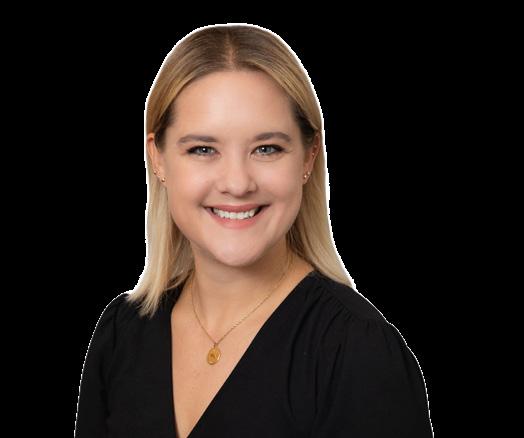
Julie Pietrzak Associate Principal
New York
“Julie is not afraid of opportunity – whether it’s the chance to step into a practice-leader role or to help Thornton Tomasetti become an indispensable part of a project team. Julie jumps in with both feet. She’s the first to volunteer, and she’s not afraid to lean in and embrace new responsibilities with enthusiasm, passion and thoughtfulness.”
–Tom Scarangello and Gary Panariello

Travis Test Vice President
New York
“Travis sees potential in even the smallest projects, since he knows they can be pathways to bigger things. From one data center, he built a client relationship that has grown to 15-plus buildings and several studies – and he’s brought additional practices and offices into the work. He knows that no matter what they ask for, we can do it.”
VALUE: WE ARE PASSIONATE ABOUT WHAT WE DO

Jennifer Grau Executive Assistant
Newark
“If something needs to be done in Newark office operations, it’s a safe bet that Jennifer has it covered. She has readily accepted many responsibilities to keep the office running smoothly, and every time we think it’ll be impossible for her to take on something else, she proves us wrong. She makes supporting the 30 people in Newark look easy. Jennifer’s passion for what she does is evident and propels our office forward every day.”
–Jun Yu and Chris Christoforou
–Steve Szycher

Vladimir Gluzov Associate
Boston
“Vladimir’s pursuit of excellence doesn’t come from a sense of duty but from his absolute love for what he does. This passion is constant, even when he’s faced with huge challenges. In 2022, Vladimir remained committed to continuing his work while also supporting his wife, who was trapped in Kyiv as war broke out in Ukraine. The caliber of his work, his commitment to both work and family, and his passion inspire us every day.”
–Brent Vollenweider and Judd Galloway
This grassroots program encourages our people to help one another thrive by recognizing excellence in their peers. Any employee can nominate any colleague, and the prior year’s winners serve as the current year’s judges.
Immediately after Hurricanes Ian and Nicole, we mobilized engineers, architects and other specialists from a dozen Thornton Tomasetti offices to help communities across Florida and up the Eastern Seaboard evaluate damage and get back on their feet.
We conducted rapid-response assessments of the safety of more than 50 single-family homes and more than 200 commercial, residential and municipal properties. And we continue to work, helping property owners understand how federal and local laws affect their plans for rebuilding.

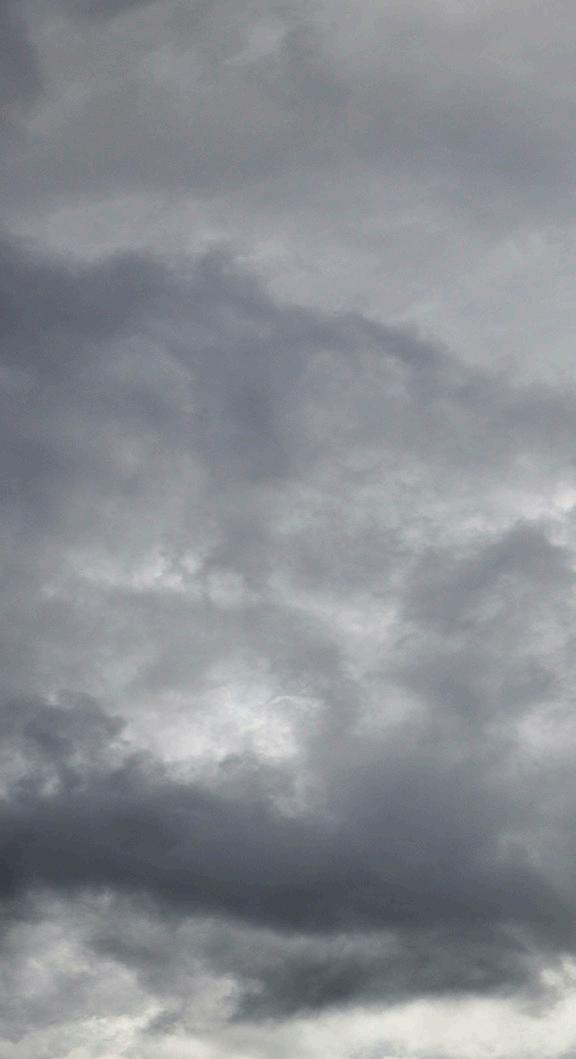
September 28-29, 2022
Category 4
(155 mph sustained winds)
Storm surge 10-15 feet
DAMAGE: $50 BILLION
November 10, 2022
Category 1
(75 mph sustained winds)
Storm surge 3-4 feet
DAMAGE: $520 MILLION

BACKGROUND: Beachfront properties across 16 counties in Florida were hit especially hard by Hurricanes Ian and Nicole.

Design and review of new medical technology, accelerated with digital twin modeling.
The biomedical industry is looking to innovative methods, such as in silico trials, to save time and resources and reduce clinical-trial risks. Combining machine learning with our engineering simulation expertise, we’re creating virtual models of living systems that can serve as a substitute for physical testing. In the U.S. market, this approach can aid both designers of new technology and the Food and Drug Administration (FDA), in evaluating those technologies.
Our team produced an in silico simulation, or digital twin, of a surgical implant of a generic stent graft for a virtual patient with a thoracic aortic aneurysm. They used machine learning to analyze how the patient’s anatomy and the structure of the stent graft affected
therapeutic outcomes. The simulation identified the inputs that will have the most influence on the likelihood of the stent migrating or leaking.
“Efficacy and safety analyses like this are critical for the efficient development of life-saving therapies,” says Kristian Debus, head of our life sciences team. “Through rapid iterations, developers can quickly zero in on optimal design strategies.”
Our next challenge? Based on this demonstrator case, we’re now developing a graphical framework that will facilitate discussions between a medical device maker and the FDA. The framework will be the first to combine real-world clinical outcomes and simulation data in this format to maximize the benefits of digital twins in device design.


Stent grafts are often used to treat aneurysms by reinforcing a weakened vessel wall. Here, we used computational fluid dynamics modeling to simulate blood flow through and around a stent graft (top), in which red denotes the highest velocity and blue denotes the lowest. The bulge above the stent shows leakage. The bottom image shows a successful stent placement without leakage, in which the aneurysm is depicted as the tan, shaded bulge.


Women@TT Portland and Northeastern’s Roux Institute co-hosted a Women in AEC event.
Advocating for wellness and allyship to unleash potential.
Since 2016, our ED&I initiative has contributed to building an inclusive environment and increasing the firm’s gender, ethnic and racial diversity. This initiative is supported at the top levels of leadership, with senior executives partnering with emerging leaders to engage all our employees. In 2022, our employee network groups (ENGs) organized 13 local and global activities supporting ED&I goals.
The flagship of our 2022 ED&I program was an Allyship Learning Series, which focused on some of the ways allies can uncover unconscious bias and advocate for others. Our ENGs produced several skits to illustrate the concept, and these engaging videos sparked
discussions among employees and raised awareness of the ways allyship can support people facing discrimination or inequity.
Our 2022 annual Wellness Challenge – in which employees competed to earn points and win prizes – evolved to intersect with our ED&I program. Activities that celebrated diversity, such as cooking healthy Hispanic/Latinx meals or getting to know co-workers over conversations about allyship, served both goals.
For 2023, we’ve adopted additional work holidays – Juneteenth, Veterans Day and Indigenous People’s Day – to provide more opportunities for the celebration of diversity.
30% are women 37% in the U.S. are from nonwhite ethnic and racial backgrounds
91% agree that we are an inclusive workplace 98% participated in one or more ED&I activities in 2022
81% report a positive impact from our ED&I programs
1,300 participated in our Allyship Learning Series
92% are satisfied with workplace flexibility
97% agree that their manager promotes ED&I objectives
We explored identity and wellness as part of Hispanic Heritage Month, and learned how cultural expressions such as food and dance can promote physical and emotional well-being, as well as diversity and inclusion.
Project Director
Jennifer Mahan Mosaic Leader
We continued to add male allies to our committees and local chapters. They’ve contributed to the development of a firm-wide learning series about the importance of male allyship.
Project Engineer
Allison Partridge Women@TT President

We saw allyship in action with Pride events across many offices. These events take us closer, step by step, to ensuring that all employees feel comfortable being themselves at work.
Senior Associate
Jake Albright Spectrum Leader


GIVING BACK
$2.74M in charitable giving since 2013
$369,859 contributed to charitable causes and organizations in 2022
1,955 company-paid community service hours in 2022
14,000 hours of community service recorded on time sheets since 2014
2,000 hours dedicated by employees to the ACE Mentor Program in 2022
Thornton Tomasetti Gives Back engages employees in mentoring schoolchildren (left) and in a variety of other volunteer activities, such as spending a day helping out at Corinthian Community Gardens in Philadelphia (right).
The Thornton Tomasetti Gives Back program supports our employees’ passion for community service.
Volunteer Days
All employees have 16 paid hours a year to volunteer in their local communities. In 2022, 248 of our people logged 976 volunteer hours in 31 locations.
Since it was established in 1994 by Founding Principal Charlie Thornton, we have been a major sponsor at the national and local
levels. Our employees are dedicated mentors and board members, working to achieve ACE’s mission to engage, excite and encourage high school students to pursue AECindustry careers.
Applying their skills and resources in one of the many disadvantaged regions of the world, a team of our people will go to Rwanda in July 2023
to build a pedestrian bridge in an isolated community – our third in that country.
Underpinning our community service is our philanthropic giving. The firm provides donations and volunteers to the ACE Mentor Program and Bridges to Prosperity. We also support many local organizations and the Thornton Tomasetti Foundation (p. 31).
Risk comes in many forms and is always changing. Think wildfires or floods made more frequent and severe by climate change. Or evolving threats sparked by cultural or geopolitical conflict. To counter these risks, protective design and security specialists are continuously adapting and adopting new strategies. But the best results always start with thorough evaluation of risk and a nuanced approach to its reduction.
Peggy Van Eepoel, managing principal and member of our board of directors, recently sat down with architect Jill Cavanaugh, a partner at Beyer Blinder Belle, to discuss the ways protective design and security have evolved in recent years – and where it’s heading.
Peggy: The solutions are much more customized now. After 9/11, a lot of measures were taken very quickly. Now there’s more thoughtfulness. We’re sitting down at the start to understand the application of security guidelines to that particular project.
And there’s more interest from nongovernment clients, such as those with cultural properties, residential, higher education facilities, and corporate owners. They have their own distinct concerns and sensitivities related to the public perception of their security posture.
Jill: And in these bespoke approaches, we can develop solutions that play to multifunctional demands. There are all sorts of wonderful things you can do – like a plinth wall for perimeter security that could also provide visitor seating or be a donor wall.
Peggy: Another big change has been the evolving threat. For a long time, we were focused on terrorism and explosives. But now it’s a vehicle attacking a crowd, in soft targets anywhere in our cities. There’s also civil disturbance, and active shooters walking into a building. We have to design for a very different threat environment today.
Jill: One challenge is designing something that can adapt as needed. As developers are repositioning office buildings as residential, you remove some measures and add others, because the threats are different. Shared streets are another example. You can create operational resilience by making it a pedestrianoriented space but use it as a road in emergency situations, as long as you account for multiple security considerations in the design.
Jill: It’s important to engage people who don’t normally have a role in security. If you ask the right questions and extract real experiences from the people who will use the building or campus, it forces you to see things in new ways, and you can gain buy-in through creative, collaborative solutions.
Peggy: We’ve also been seeking early input from people who will actually secure the space. Because often they’re not consulted, and then say, “There are all these blind spots. I need 15 more people.” So involving them can lower life-cycle costs.
Jill: And when security solutions are baked into the design process from the start, it can feel less intimidating or exclusionary.

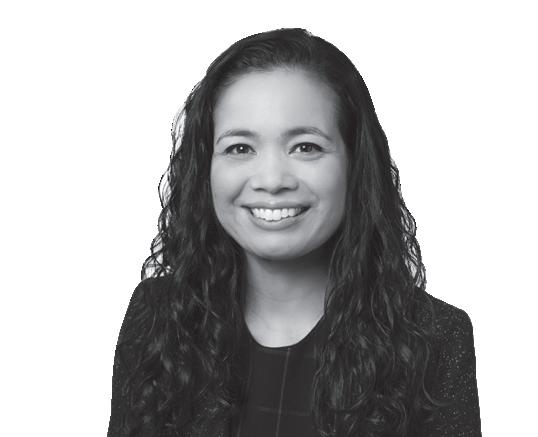

WHAT CHANGES DO YOU SEE COMING?
Peggy: One is multihazard design that considers overall resilience. By evaluating the risks of natural and human-made hazards together, you find opportunities for more holistic solutions.
Also, more interest in technology: facial recognition, biometrics or smart cameras that can pick up weapons, for example. There’s interest in creating an invisible perimeter or not having screening, where you’re taking things out of your bag.
Jill: Understanding peoples’ level of comfort is key. Will they feel like they can board an airplane without going through security, even if biometrics allows for it? And perceptions of risk can change quickly. Take being in crowded public spaces: what was unthinkable three years ago is now commonplace again. People’s comfort with it changed dramatically in a very short time.
Peggy: There will be more tension between privacy and the invisibility of security. It starts to get into complicated ethical questions. But there are practical issues associated with it, and those will be on the forefront for us, as designers, to best guide our clients.

At the National Institute of Standards and Technology (NIST) in Gaithersburg, Maryland, the Radiation Physics Laboratory, also known as Building 245, has been the site of research that is vital to healthcare, national security and nuclear-energy safety since 1964. But by 2016, it was overcrowded and its structure and building systems were well past their prime. NIST developed a plan to expand and renovate the facility in preparation for another 50 years of service.
Operational needs (for uninterrupted function) and the funding pipeline caused the project to be split into several phases. We were the protective design and structural consultant for the phase 1 design-build team, led by contractor Hensel Phelps
and architect ZGF, that was awarded a fast-track contract to build the H Wing, a 77,000-squarefoot addition. Our team was then selected for subsequent phases, including a second, smaller addition and modernization of the original building.
SECURITY MADE TO MEASURE
Building 245’s mission requires the facility to meet Interagency Security Committee (ISC) standards. Specialists from our Protective Design and Security practice worked closely with the design team to ensure that physical and

The cladding of the H Wing addition (foreground, left) was designed to complement Building 245’s mid-century style. The western half of the building’s exterior (right) is a new façade that mirrors its original appearance.
operational security requirements were understood and correctly implemented. The building is on a secure NIST campus, so we also coordinated with the institute’s security team to review the ISC criteria and develop a customized security matrix that avoided unnecessary and costly duplication of risk-mitigation measures.
Because the NIST campus is eligible for inclusion in the National Register of Historic Places, the façade’s appearance had to be preserved. Our team collaborated with ZGF and the Maryland Historical Trust to design a new building envelope that reflects the aesthetic of the original while incorporating modern blastresistance features.
The work underway at Building 245 involves ionizing radiation and supersensitive equipment, so the structural design had to do more than just hold the building up. The H Wing, a five-story structure with 38 new laboratories and 2,500 square feet of class-100 cleanroom space, required a robust concrete frame to support heavy machinery, dampen vibration and provide radiation shielding.
When the project required sophisticated vibration testing, our acoustics, noise and vibration experts joined the team. Footfall vibration analyses and in situ
measurements of wave propagation – from adjacent corridors and within laboratories –allowed us to meet the baseline vibration-criteria velocity of 2,000 microinches per second while reducing the thickness of some slabs, thereby lowering both costs and embodied carbon.
Our team also monitored vibration during construction to prevent underground labs with sensitive instrumentation from experiencing potentially damaging movements.
With construction concluding in 2023, the scientists in Building 245 have up-to-date facilities where they can continue their work of helping make people around the world safer and healthier.
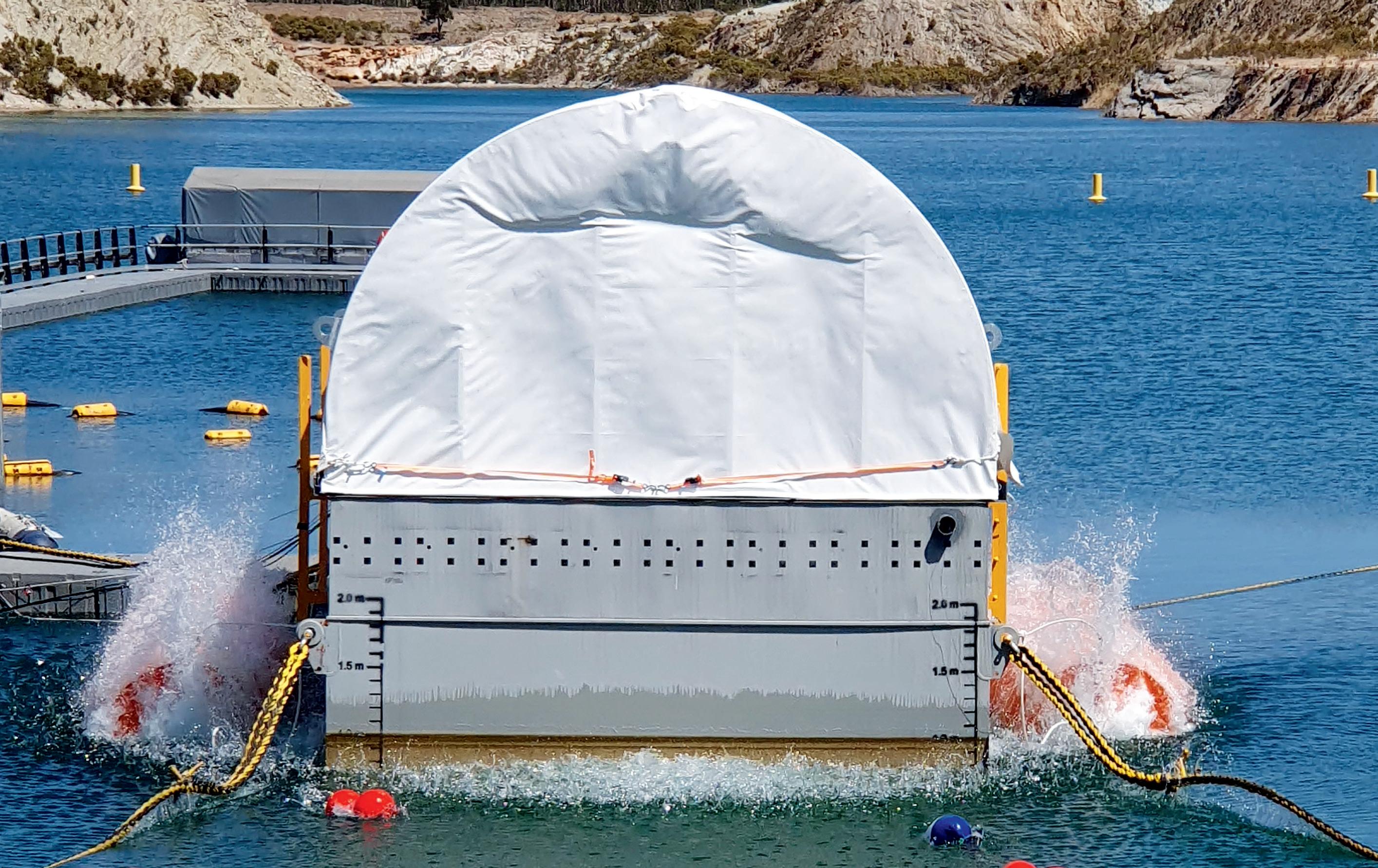
Australian floating platform shock test performed with a Thornton Tomasetti airgun array.
Inthe civilian world, we talk about resilience; the military equivalent is survivability. Survivability testing and design seek to ensure that military systems can operate in and withstand hostile environments to minimize the risk of damage or destruction and reduce risk to military personnel.
Warships and submarines are some of the most complex systems on the planet, and every design decision has an impact elsewhere on the vessel. So it’s critical to understand how the platform and its components will behave when exposed to realworld conditions.
We employ a variety of techniques to maximize survivability. We use advanced modeling and simulation – based on nonlinear
finite-element techniques and complex computational fluid dynamics – to predict how combat threats will affect systems. We also perform testing to validate our predictions and provide evidence of a design’s suitability for service.
But we’re not just testers. Our engineers, physicists, naval architects, mathematicians, software developers and technicians support our clients in every aspect of survivability. We help write survivability standards and assist in enforcing compliance. We work with manufacturers within the supply chain to apply those standards effectively. And we
collaborate with our clients through the entire project life cycle.
Our objective is to protect military hardware so these complex systems can continue to fulfill their mission under the harshest conditions. But behind every decision we make, our ultimate goal is to protect the lives of the men and women who are placed in harm’s way.

Security isn’t one-size-fitsall. University campuses, residential buildings, cultural institutions, retail properties, event venues, infrastructure and government facilities all have different threat profiles, which require tailor-made measures.
Whatever the project, electronic

security should work as part of a holistic solution, so our first task is to talk with stakeholders to clearly understand their needs. Our experts assess each situation and determine the appropriate balance between security personnel and electronic systems. Then we work with the design team to ensure that our recommendations fit seamlessly into the overall project vision.
From kickoff through implementation, we’re there to support every client with integrated, easy-to-use security systems that meet their unique needs.
Identifying accident risks.
Developing risk-reduction measures. Ensuring regulatory compliance. These tasks are a significant part of the day-to-day work in our Melbourne, Perth and Sydney offices. For many of our projects – including those for offshore production and alternative energy facilities – the focus is often on fire and blast engineering and on ways to protect critical systems and structures.
Over the past year, we’ve worked with Defence Australia’s Directorate Naval Engineering and Defence Science and Technology Group (DSTG) to perform shock commissioning trials. Explosive ordnance and a Thornton Tomasetti
airgun array were used to commission an Australian floating shock platform. The first trials of this type to be held in Australia, the tests will advance the defense industry’s in-country ability to conduct systems and equipment
qualification and heavyweight shock testing.
The completion of the airgun trial also coincided with the arrival of the Australian JASSO mediumweight shock-test machine at our Melbourne office.

We developed JASSO, a portable shock-test machine. Its versatile design allows it to deliver a wide range of dynamic shock inputs.
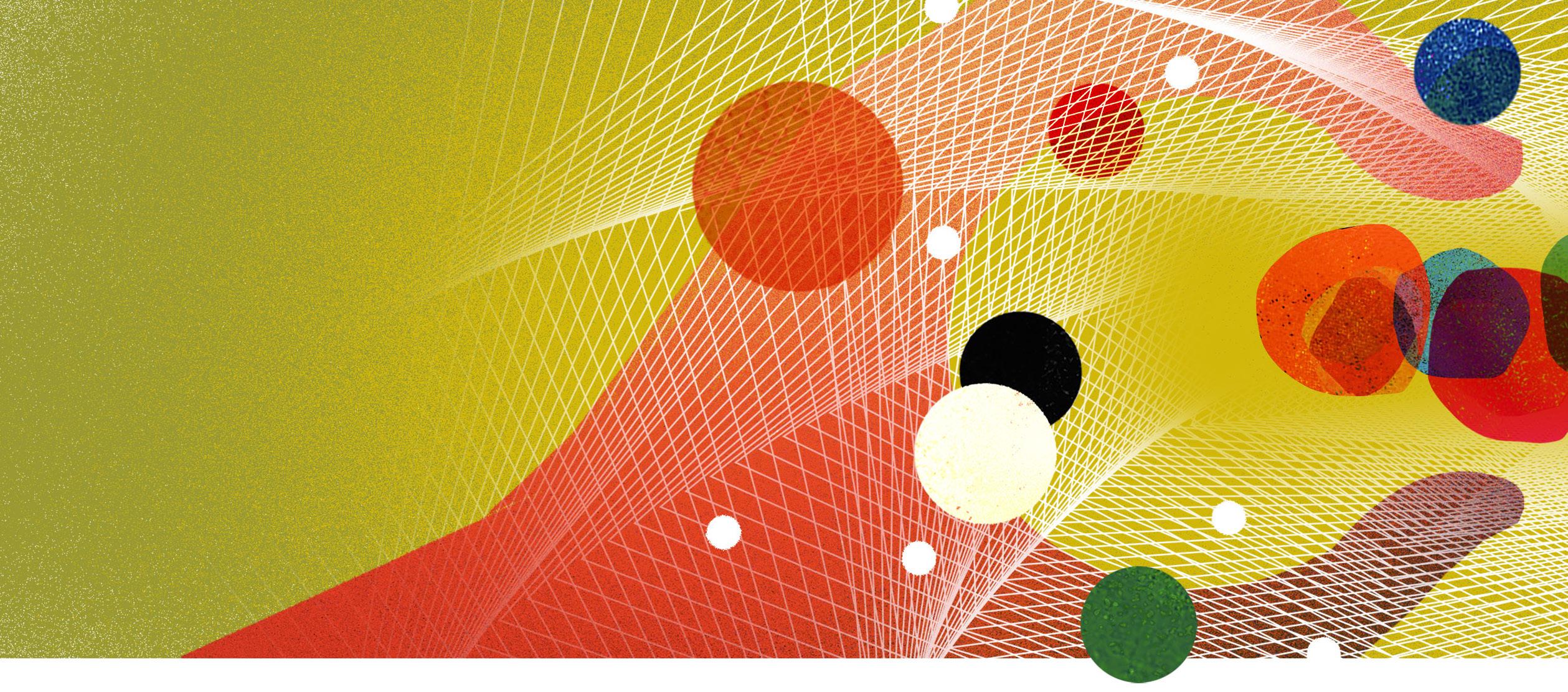
Climate change. Clean air and water. Housing shortages. These issues compel our industry to expand the idea of a project to include its broadest implications – and through our work, address them. Our Co-CEOs, Pete DiMaggio and Mike Squarzini, offer their perspective.
HOW HAVE THE BIG ISSUES OF OUR TIMES – CLIMATE CHANGE, ACCESS TO HOUSING, LIVABLE CITIES AND MORE – CHANGED OUR INDUSTRY?
Pete: A decade ago, our clients were building owners, architects, developers, government agencies and attorneys who needed help solving problems cost-effectively, safely and constructably. Now, our clients also include energy companies, technology consultants, groups looking to transform the future of transportation, material fabricators, battery and chip manufacturers, and a host of others. They’re focused on their businesses while also looking to address global challenges like climate change, decarbonization, resilience, and social issues in an environmentally sensitive and sustainable manner.
AS CLIENTS AND PROJECTS
BECOME MORE DIVERSE, WITH BIGGER-PICTURE PERSPECTIVES, ARE WE BECOMING MORE OF A DATA INDUSTRY?
Mike: Engineers have always used data in their work process –academic research, codes, analyses, schedules, costs. When it’s interconnected, data can be leveraged in new ways to improve that process. Machine learning and AI, for example, are helping us make more informed decisions faster and deliver projects more effectively. The tech industry is trying to connect disparate data sets in innovative ways to give clients better insights– everything from algorithms for rapid feasibility studies to parametric optimization–and automating builders’ workflows through construction.
Pete: When we factor in sustainability, resilience, and low embodied and operational carbon, we have to run the numbers. Should our design use steel? Concrete? Timber? Some combination? Can we tap into renewable energy sources? Electrification to support decarbonization? Getting the answers is data intensive.
Learn more about advanced modeling on page 50.



SO THIS NEED IS DRIVING MORE OPEN DATA ACCESS?
Mike: Yes. Years ago, stakeholders were reluctant to share their data. But if you want a zero-carbon building, every project consultant needs access to it. There’s more willingness to share detailed models with information that stakeholders can rely on – such as material quantities – rather than static 2D drawings. Related to data – and in many ways, enabling it – is the technology swirling around everything we do. For young engineers, it can be a challenge to avoid being swallowed by it. Technology can increase efficiency and facilitate learning, but it’s not a substitute for learning. Engineering intuition still develops through mentoring, vigorous questioning of ideas and understanding the process of building.
Pete: This raises a question: do we, as an industry, say yes, and more often because of our ability to combine creativity and innovation? It certainly helps, but I think the real driver of yes, and is our clients. In the past five years, more clients have started thinking about the impact of what they’re trying to achieve on what’s happening around them. Their vision is widening. They want to know the environmental or social impacts of their decisions. In the past, we’ve looked to government to drive change at this scale. Now, industry has realized that, at minimum, we must partner with government, and when it’s not moving in the right direction, we have to lead. That’s a sea change.
Mike: And with our clients saying yes, and, it becomes the inspiration for project teams to collectively ask, “Yes, and can we explore a path that’s different from any we’ve taken before?” In most projects, these new questions – about embodied carbon, clean air, sea-level rise – are inextricably linked to the project’s outcome. I believe that every stakeholder in our industry has the responsibility – as individuals, companies, government agencies, clients, developers and builders –to address the big issues of our times. With all of us aligned, our industry will continue to make a positive difference.
CORE, our virtual idea incubator, includes CORE studio, CORE lab and CORE.AI. Since its founding in 2014, CORE has branched out from advanced computational modeling and tool development. Today, it coordinates all our internally funded R&D efforts, employing science, technology, AI and machine learning to inform a wide variety of applications.
In 2015, CORE began researching AI/ML as a way to automate simple but time-consuming tasks. In 2018, we formed CORE.AI to develop AI/ML processes and tools for our technical teams. We now have a library of applications that are faster than traditional methods, and we’re continuing to apply AI/ML to enhance efficiency and creativity in all aspects of our business.
Our R&D grant program empowers our people to propose process improvements or develop new methods and technologies. All employees are encouraged to submit ideas for consideration. Proposals that receive funding may be incorporated into existing business practices or transition to TTWiiN, our technology accelerator (p. 48). Funded projects have ranged from analysis of fusion reactors and thermal façade performance to pilecap design and weather prediction.
Nuada.CFD’s virtual environment brings computational fluid dynamics (CFD) to Rhino, enabling users to easily create CFD wind simulations directly from Rhino geometry. The app analyzes wind flow between buildings, pedestrian comfort, structural loading and façade pressures. In preparation for an April 2023 public launch, we’re making refinements to such features as the app’s ability to visualize analysis results in Rhino 3D.

As part of the master-planning process, we used Nuada.CFD to assess pedestrian wind comfort around and on top of Stockholm Central Station (p. 6).

Using our real-time data collection and classification tool is like putting Post-it notes on 3D objects. The mobile app simplifies on-site data collection and communication among users by creating and uploading augmented-reality notes and screenshots to the web. The web app lets managers assign notes to categories, manuals, assets and users. SHoP Architects and CORE studio collaborated to create the app infrastructure, which is customizable for commercial use.
This cloud-based data studio app provides a central location where stakeholders can view and interact with any segment of a model. Ellipse’s industry-tailored dashboards combine interactive 2D drawings, 3D models, and BIM and analytical data with descriptive text and media – giving each user information in their preferred format. It encourages collaboration across teams and locations, enabling instant feedback and informed decision-making.

Create and share sticky notes with colleagues onand off-site simultaneously.
Our Shear Wall Automation Platform (SWAP), which imports ETABS model data to perform whole-building shear-wall design, continues to streamline the design process. Recent enhancements include a model-tree view, the ability to move piers across groups, easier management of tier divisions, and the ability to restore snapshots and update forces from modified models. SWAP’s visualizations provide valuable feedback during design, and detailed material quantities afterward.
The AEC Angels investment platform continues to grow, with recent additions to our portfolio, which now comprises 10 start-ups across three major domains in the AEC technology space: process, product and performance. AEC Angels began 2023 with investments in TestFit, ProPlanner, Green Badger, EnviroPower, Aeromine, Assembly OSM, Falkbuilt,
OpenSpace, Rhumbix and Reconstruct. Our strength is our unique ability to leverage the expertise of our founding members: Thornton Tomasetti, STO Building Group (formerly Structuretone), Syska Hennessy and SHoP Architects. Together, we analyze and test target investments with a unique industry-based approach to due diligence, and we provide direct post-investment
TTWiiN Investment Partners is invested in several leading AEC technology funds, such as MetaProp, Building Ventures, Shadow Fund 1 and 2 and the Parkway Ventures Fund, and has made direct investments in XtreeE. Through our participation in these funds, we are invested in 76 start-ups in our sector, providing broad exposure to our constantly changing industry.

T2D2 generated this façade orthomosaic, in which the colors denote artificial intelligence detection of various conditions, including cracks, spalls and organic growth.

T2D2 We launched version 2 of our AI-powered damage detection and classification platform recently, incorporating numerous new user-friendliness features that we anticipate will accelerate sales in 2023. Recent clients include Hines, Bloomberg, the Howard Hughes Corporation, GFP Real Estate and Magnox. t2d2.ai
support through product utilization and promotion on actual projects. During our monthly meetings, we continuously review and analyze multiple new targets.
“New technology solutions and products are coming to market daily, supported by myriad trends such as machine learning and AI, and by real-time project collaboration,” says Grant McCullagh, managing director
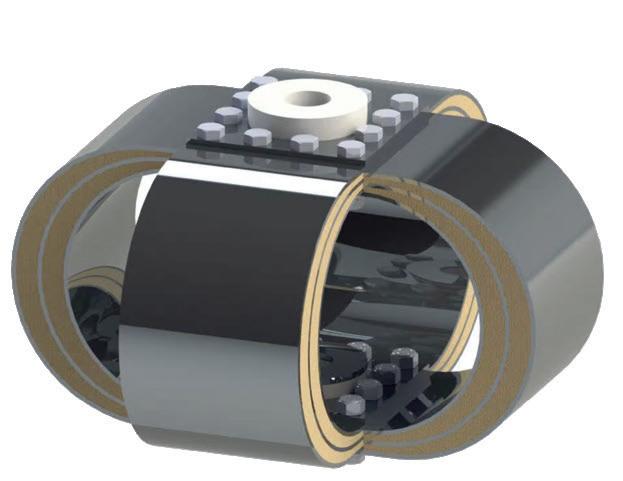
PUMPKINTM Mounts This product (pictured above) combines a stainless-steel leaf spring with a constrained layer damping compound, producing a heavily damped isolator that arrests violent shock motions and mitigates extreme vibrations. Taylor Devices, our strategic partner, has completed a test compendium that will accelerate marketing and sales initiatives focused on protecting sensitive equipment within transportation containers. TaylorDevices.com/Products/PUMPKINmounts
OnScale In late spring 2022, completion of the purchase of OnScale, our cloud-based engineering simulation software company, by Ansys was recognized as a significant transaction in their space. “This is an excellent example of combining unique IP with a SaaS-based platform with growing applications to drive a successful sale to a strategic buyer,” says McCullagh. OnScale.com
KONSTRU data visualization of the Tata Innovation Center, New York City. ‘‘Technology is rapidly transforming processes, products and performance in the AEC industry. We apply industry experience and expertise to mentor leaders and drive innovation.” –Tom Scarangello
of AEC Angels and TTWiiN. “AEC Angels is one of several avenues Thornton Tomasetti has established to monitor and review a broad range of software and products as they flood the market, as well as participate directly in selected investments.”
AEC-Angels.com
Hummingbird After a lengthy process, we have a clear path to a final patent award this year. Combined with a post-COVID office tower business environment, we are working with our partner, RWDI, on a variety of growth options in 2023. HummingbirdKinetics.com

ShapeDiver With the release of ShapeDiver 2.0, which fully integrates Swarm, the Grasshopperbased online codesign application now has a revamped user interface, full augmented-reality integration and enhanced team collaboration features. ShapeDiver.com
KONSTRU This 3D BIM common data environment interoperability program and digital-twin facilitator has gained traction in the industry and is widely used at Thornton Tomasetti. Our team has begun preliminary conversations with multiple strategic industry partners to discuss both collaboration and potential investment. KONSTRU.com
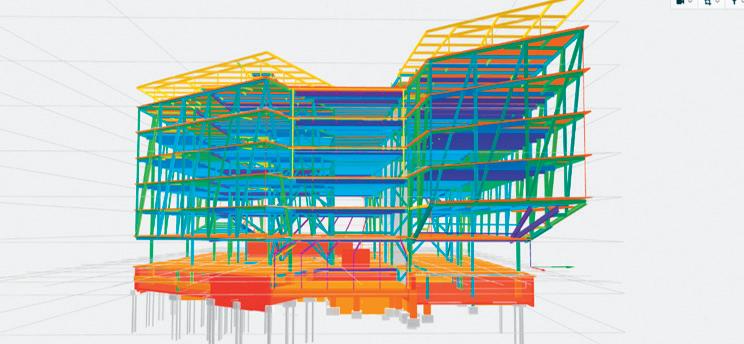

Engineers often design to probabilities based on a collective understanding. Many questions are, therefore, variations on familiar problems. But with advanced modeling, you’re looking at unique scenarios – how something fell apart or how a series of loads might impact the behavior of a structure. It includes details that can’t be captured by standard methods.
Such details might include exact geometries – which can affect air or water shock propagation through a structure – site-specific soil properties that directly influence structural response, or numerous possible response modes that are beyond the reach of simpler tools. All these elements lead to more accurate predictions of real-world
behavior, which can translate into increased safety margins or financial savings for the client.
More generally, advanced modeling is less a property of a particular model and more an embodiment of advanced thinking. It might replace an off-the-shelf method with a new or bespoke approach that offers greater accuracy, precision or efficiency. It’s relatively easy, for example, to build models that run on brute force with massive number crunching. But models that elegantly streamline the process or effectively approximate complicated physics (or both) are harder to conceive and build.
A model that incorporates variables that older models can’t accommodate also qualifies as “advanced” – for example, a model of a failure that includes not only present strain but strain and stress history. That history gives a more complete picture of the mechanism or progression of the failure.
Or “advanced” could be using a conventional model in an unconventional way, such as adding new variables or changing the input sequence. For instance, while accurate modeling of how a shock wave affects a structure requires a lot of fundamental knowledge and experience, we work with an added complexity when we model a coupled
We convened a group of our modelers, scientists and engineers – who do everything from structural design and computational fluid dynamics to materials characterization and failure analysis – to explore what advanced modeling is, why it matters and where it’s going. Here is a summary of their thinking.
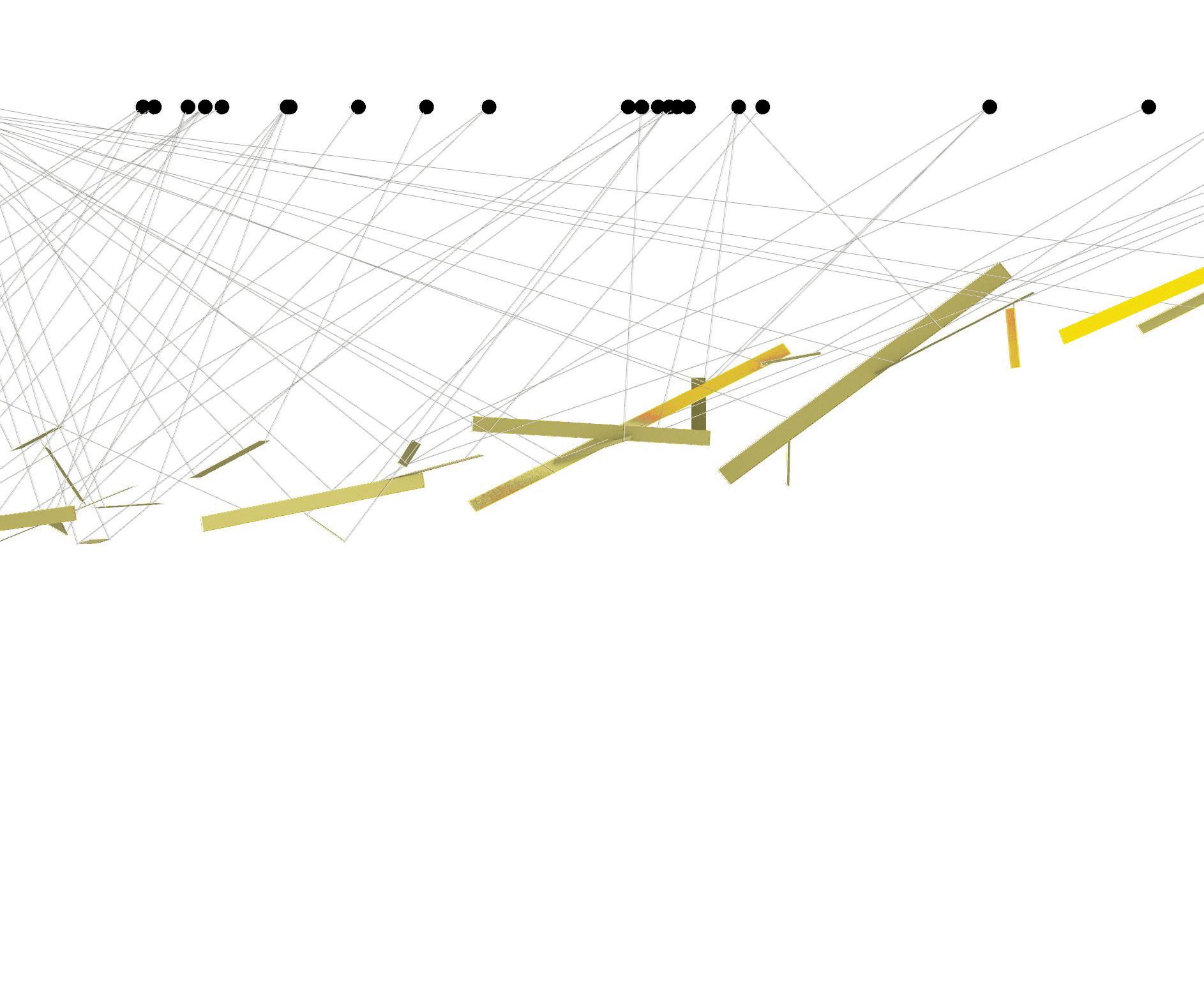
Our advanced parametric model allowed designers of this sculptural feature to stretch, squeeze and bend each piece independently to best fit the space.
response in which the structure affects the shock wave. Addressing coupled problems is already leading to more accurate predictions of behavior, reduced uncertainty and better quantification of risk factors. Coupling fluids (air or water) with structure enables both blast analysis and soilstructure interaction modeling, which gauges the effects of earthquakes or adjacent construction on structures.
(AI) & MACHINE LEARNING (ML)
Algorithms for ML are becoming more advanced, and data workflows are allowing modelers to solve problems faster, which permits engineers to be more
creative. Computational fluid dynamics and finite-element analysis codes can generate terabytes of information, and AI/ML is perfectly suited to digest all this data and democratize it to produce informed decisions faster.
Methods of ML interpolation are improving, so we can generate more accurate outputs with fewer data point inputs, which saves time. The ability to pull relevant information from enormous data sets has also improved greatly in recent years. Façade damage detection, for example, is now better than ever at distinguishing a crack from a tree branch or a reflection. The result is better structured predictions that enable better decisions faster.
In the next five years, we can expect to see more real-time
analysis. And communicating modeling results to the client or end user will become easier. In the near future, clients will be able to “spin the dials” themselves and chain together models that look at varying levels of detail. We’ll also see different parts of an analysis come together, with more coupled intelligent models that influence each other.
In the end, it comes down to people. We use advanced modeling when we advance our own thinking and say yes to something that might, at first, look crazy. That’s often how we discover what’s possible.
CONTRIBUTORS
Liling Cao, Eric Hansen, Andy Nelson, Rob Otani, Pawel Woelke, Saffron Wyse

Saying yes, but is tempting, because . . .
• The rapid pace of change is making traditional planning obsolete.
• Unknown unknowns outnumber known unknowns.
• Stakeholder expectations have risen.
• Global execution is more complex than ever.
• Sustained success requires flexible thinking.
To this, we suggest the art of the possible. Saying yes, and . . .
• Nurtures thinking and behavior needed for learning and cocreation.
• Empowers diverse voices and perspectives.
• Removes barriers that limit creativity.
• Strengthens the social fabric needed for collaboration and experimentation.
• Unleashes everyone’s slice of genius.
When we embrace yes, and, we open ourselves to ideas that work, that bring everyone together and that include adjacent possibilities. Then we can achieve what initially seemed daunting.
And when we all gather around the table to celebrate, we’ll ask, “When can we do it again?”
Additional Photography:
Ilustration:
All uncredited images, except p. 20-21,
Courtesy Ramboll: p. 13, left
Sergio Soltero: p. 19, second from left
Courtesy Stanford University: p. 25, center
HeadShots, Inc: p. 25, right
Sergio Soltero: p. 32, right
Courtesy Beyer Blinder Belle: p. 39, left.
We help clients create enduring solutions in many fields. Buildings, old and new. Transportation and infrastructure. Decarbonization, sustainability and resilience. Energy and industry. Advanced modeling and simulations. Forensic investigation. Our engineers, architects, scientists and sustainability experts collaborate from 45+ offices worldwide to bring your goals to fruition.
Acoustics, Noise & Vibration
Aviation
Biomechanics & Life Sciences
Commercial
Construction Engineering
Critical Facilities
Cultural & Community
Decarbonization
Defense
Education
Energy
Façades
Forensics & Investigations
Government
www.ThorntonTomasetti.com
Healthcare
Hospitality & Gaming
Insurance
Laboratory & Research
Protective Design & Security
Residential
Resilience
Restoration & Renewal
Special
Structures
Sports & Public Assembly
Structural Design
Sustainability
Tall & Supertall Buildings
Transportation & Infrastructure